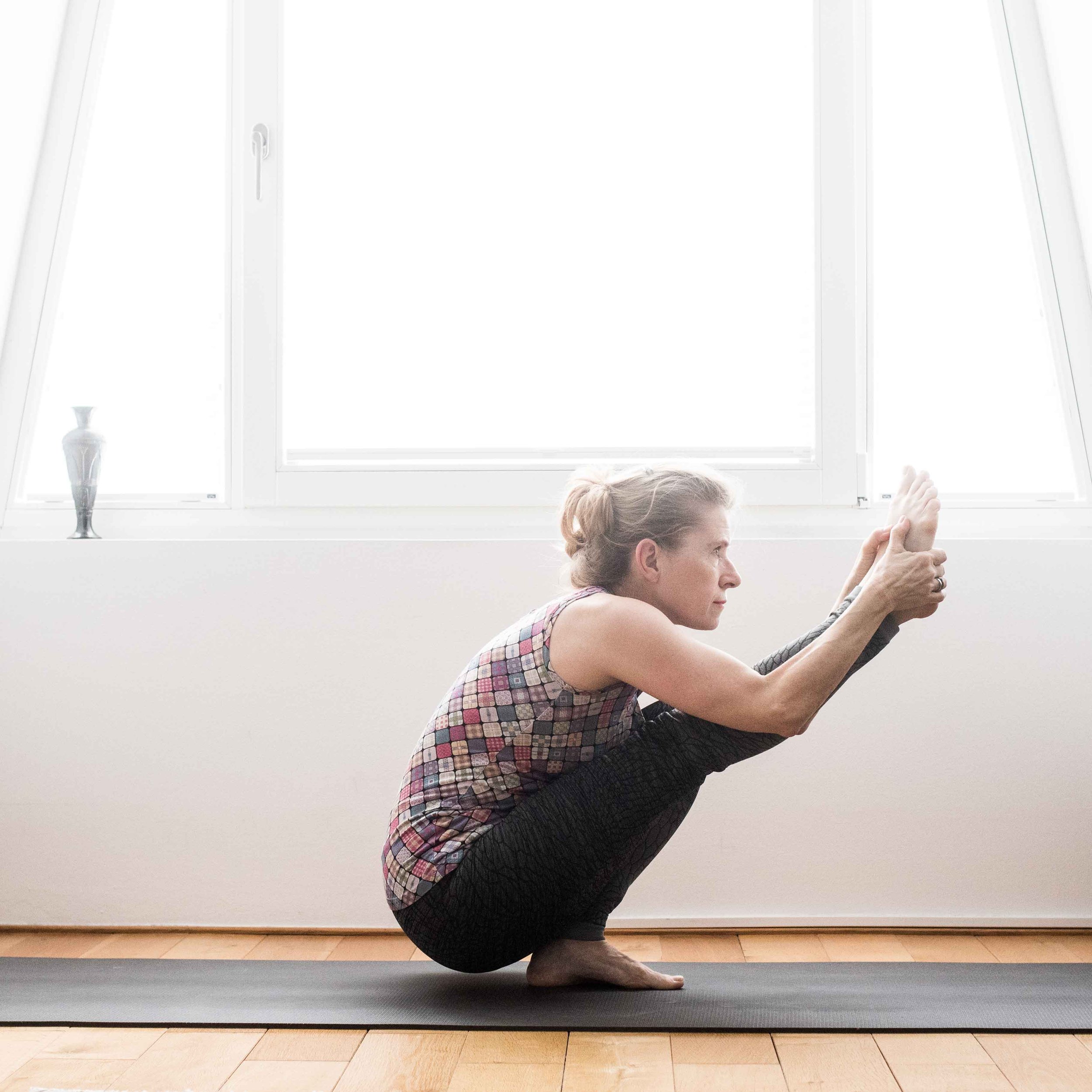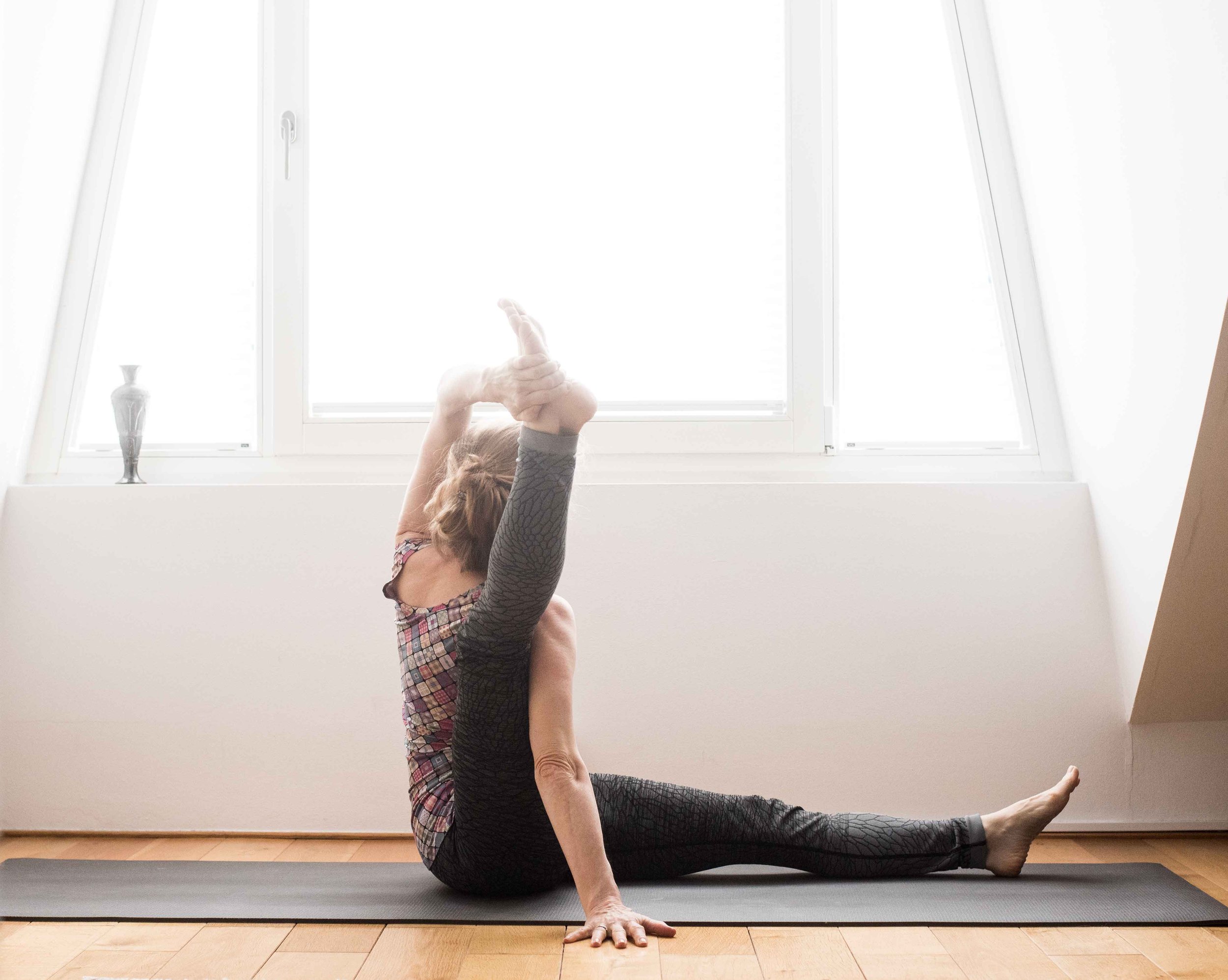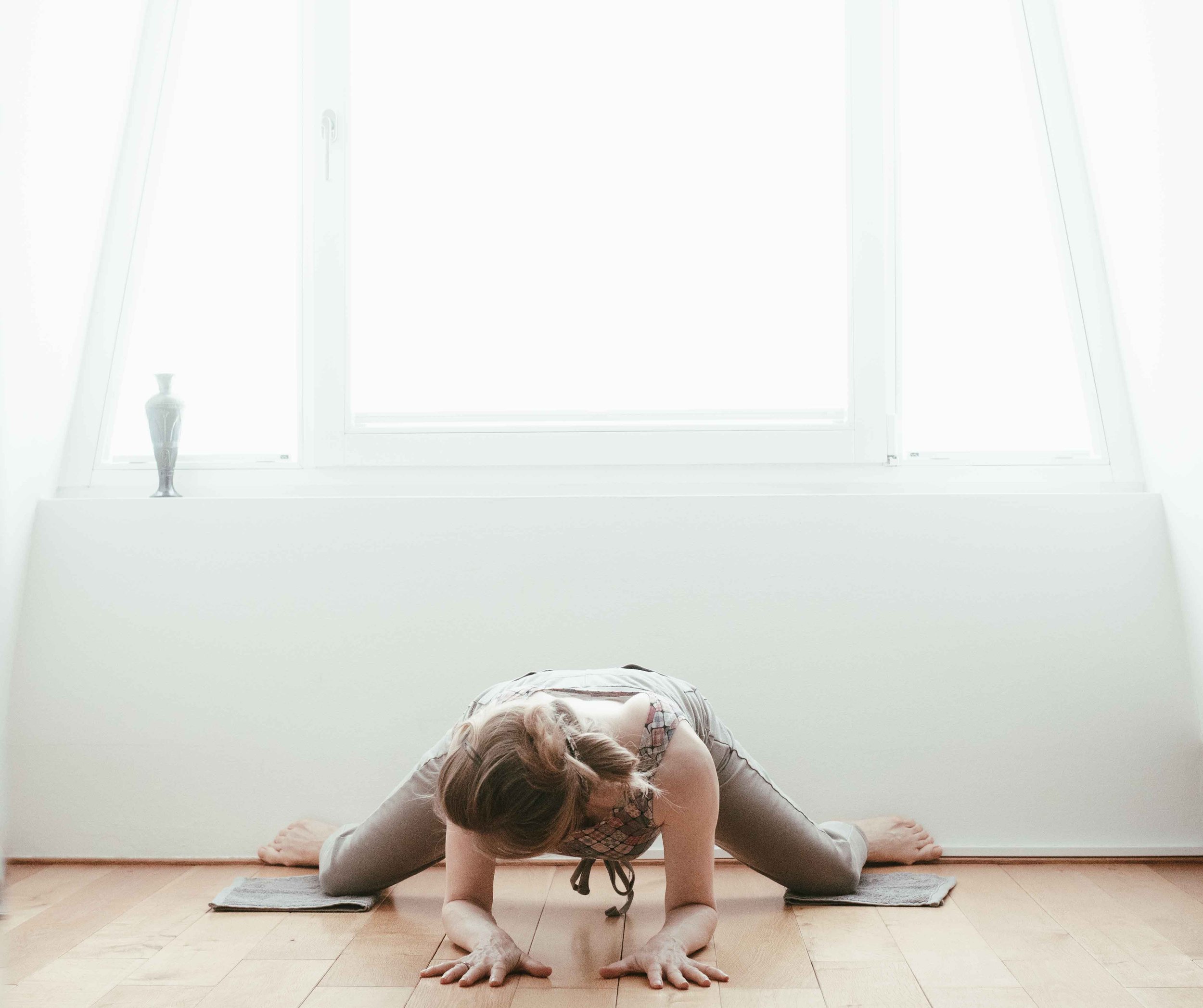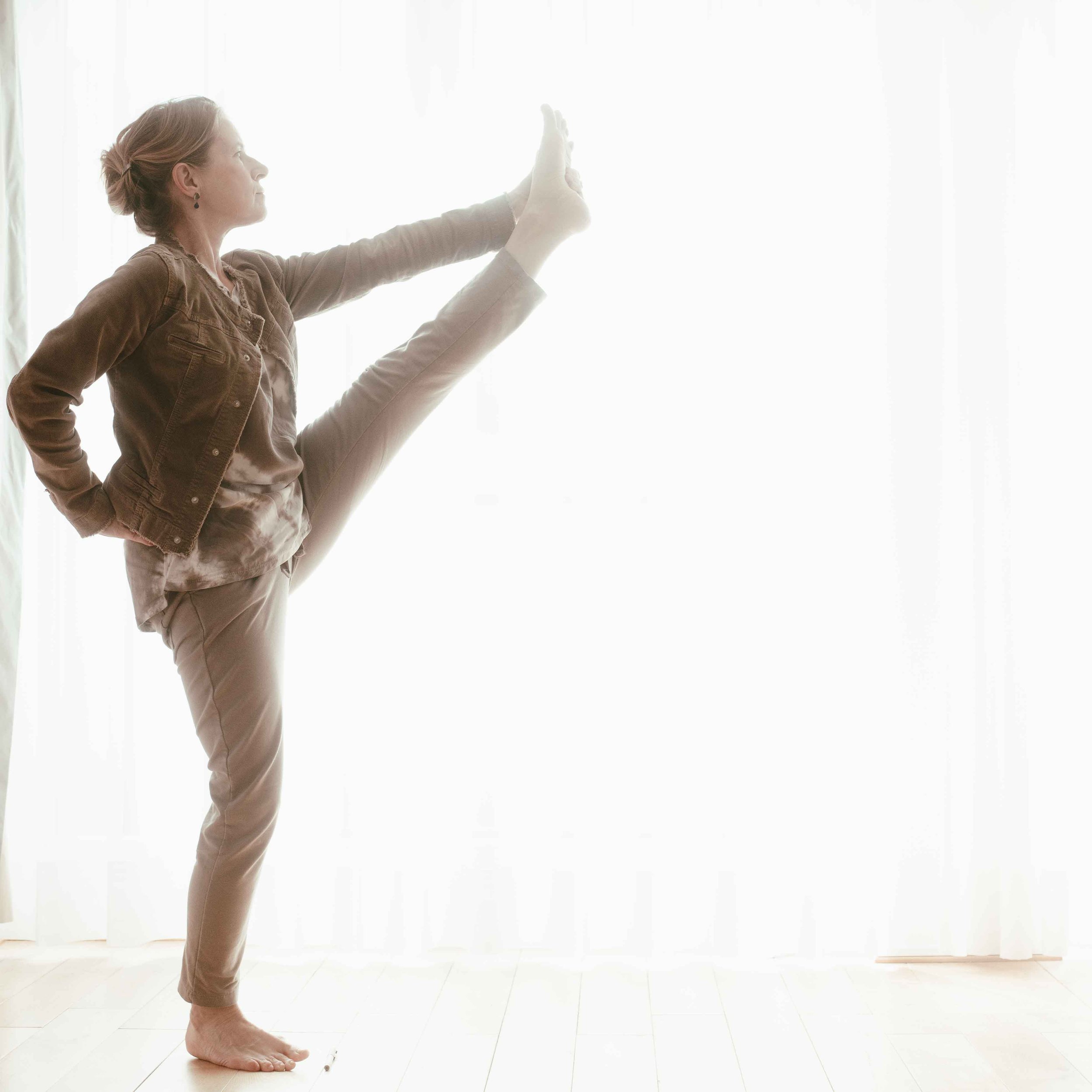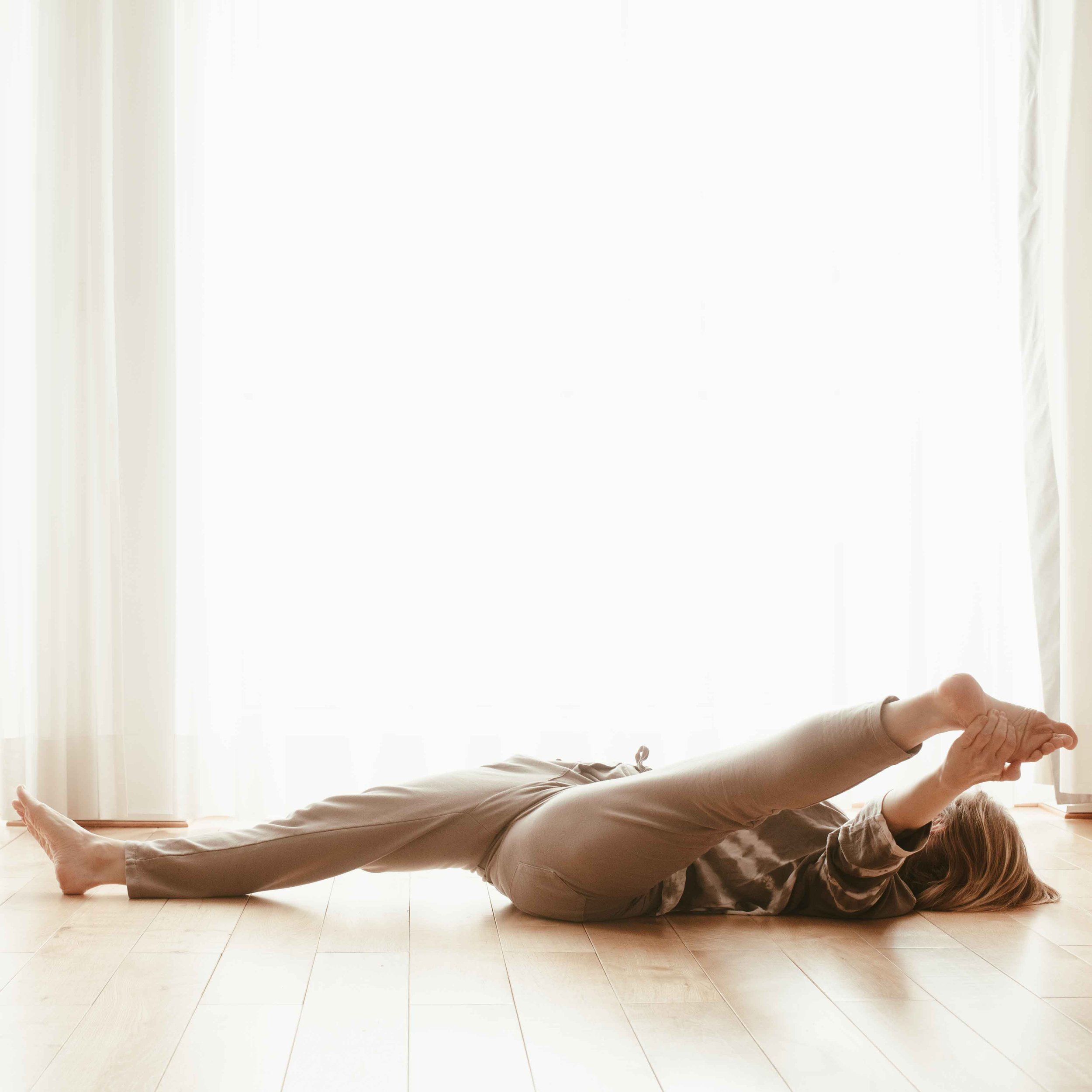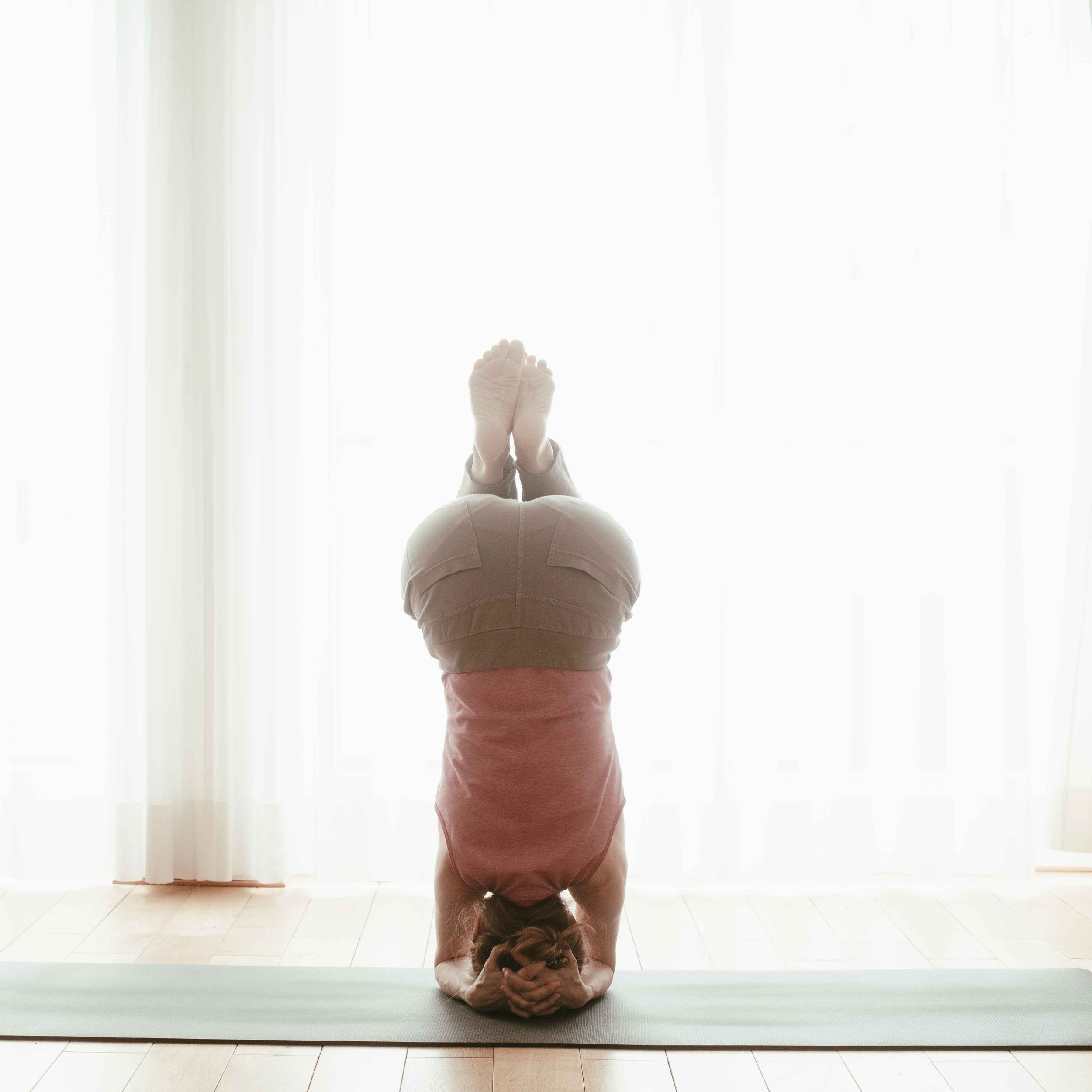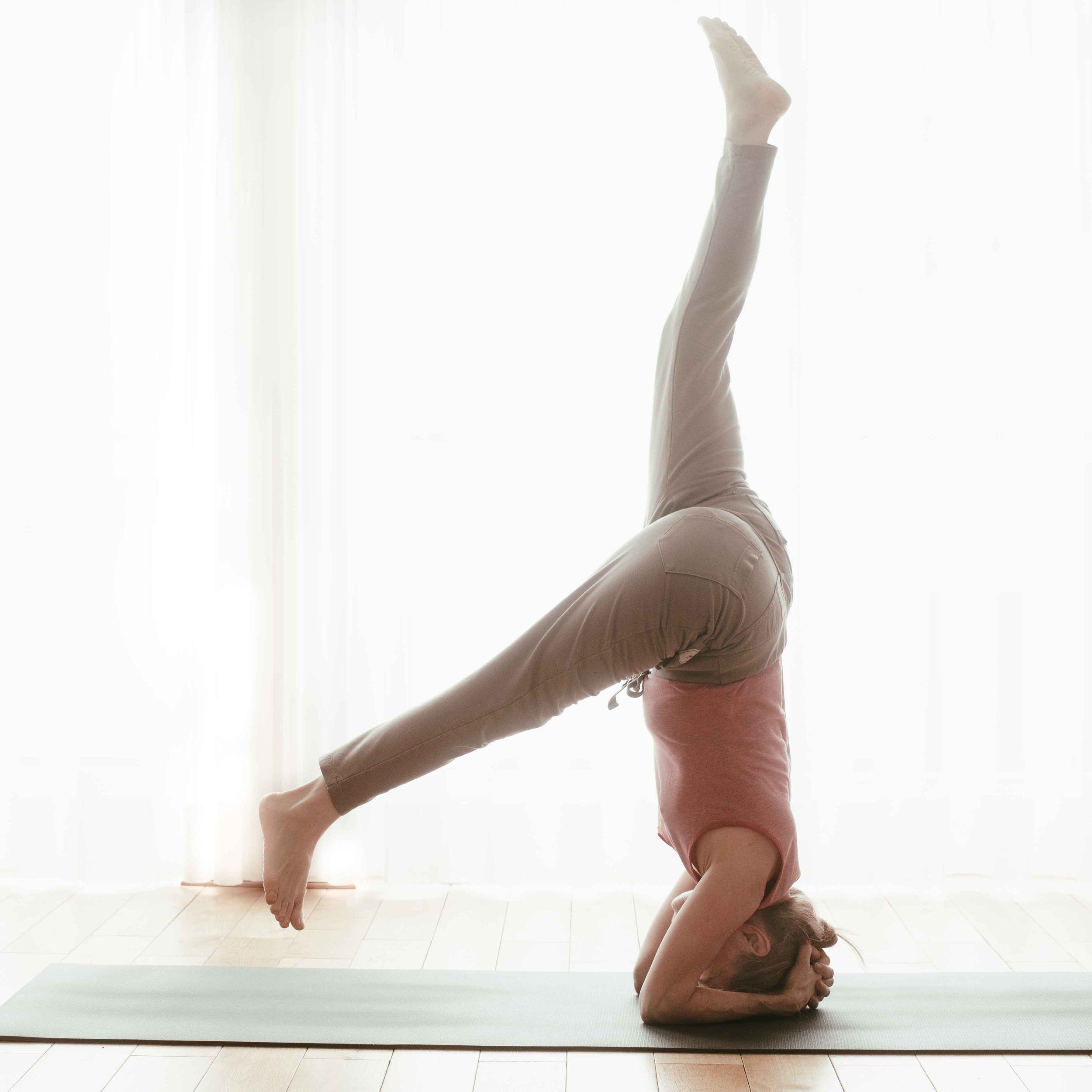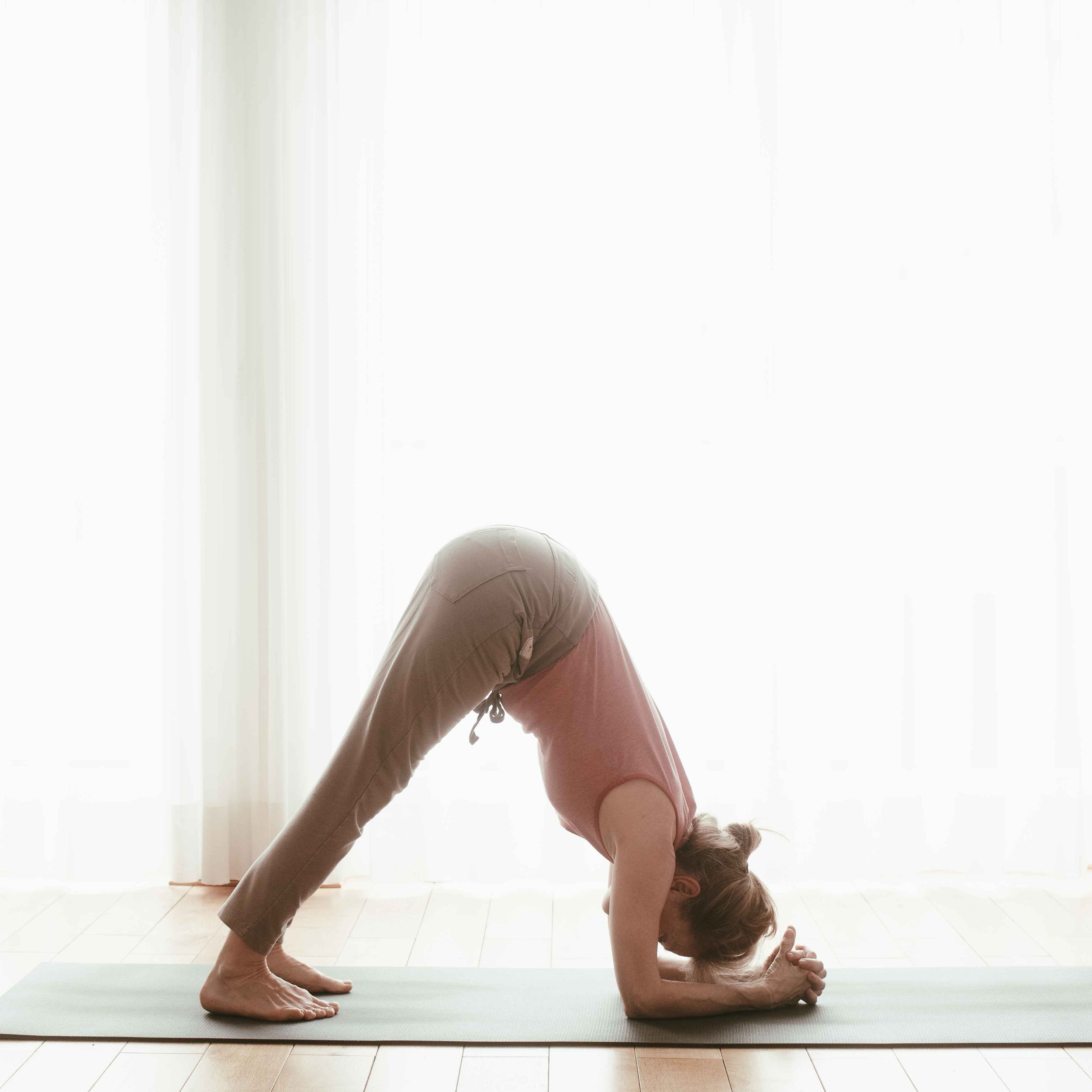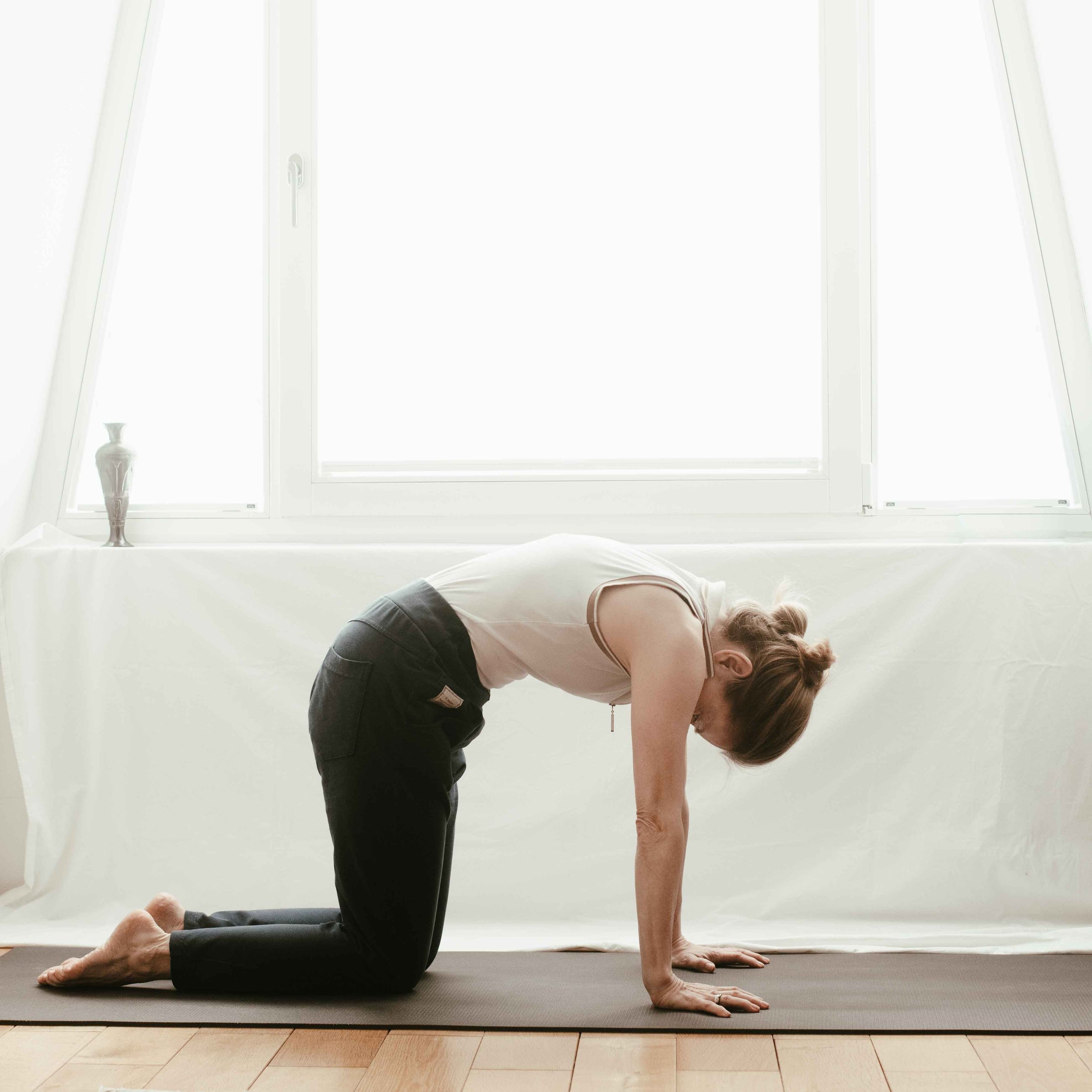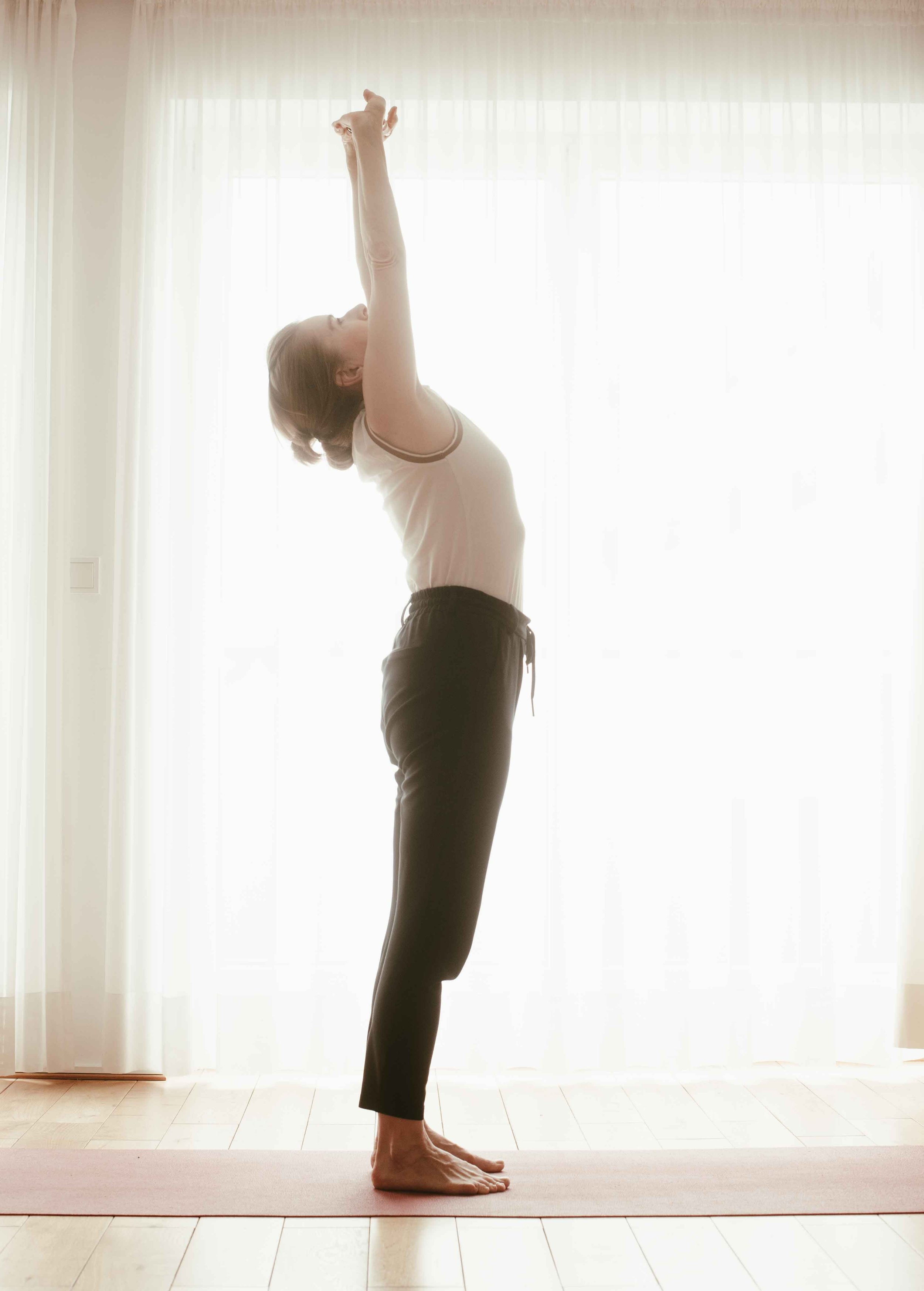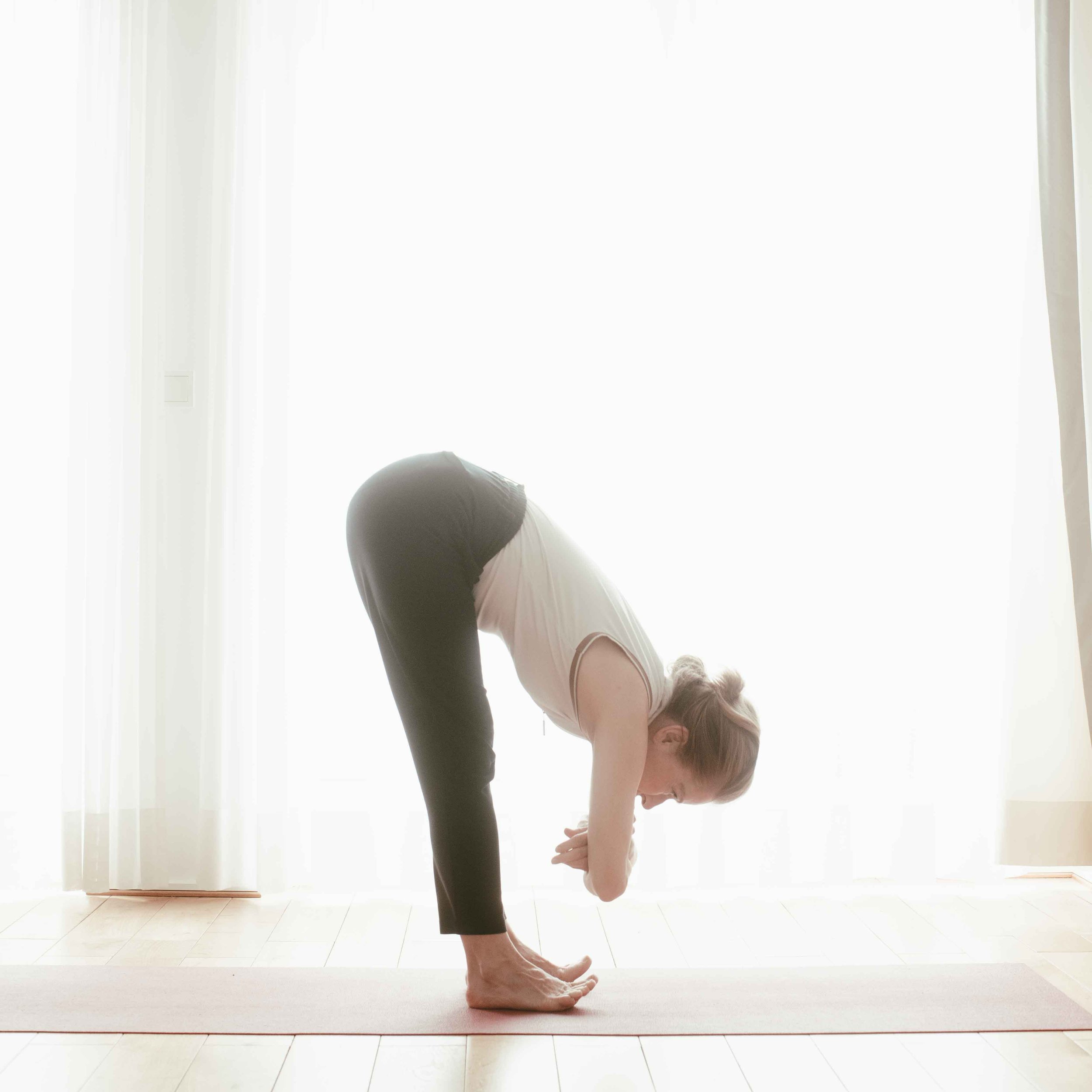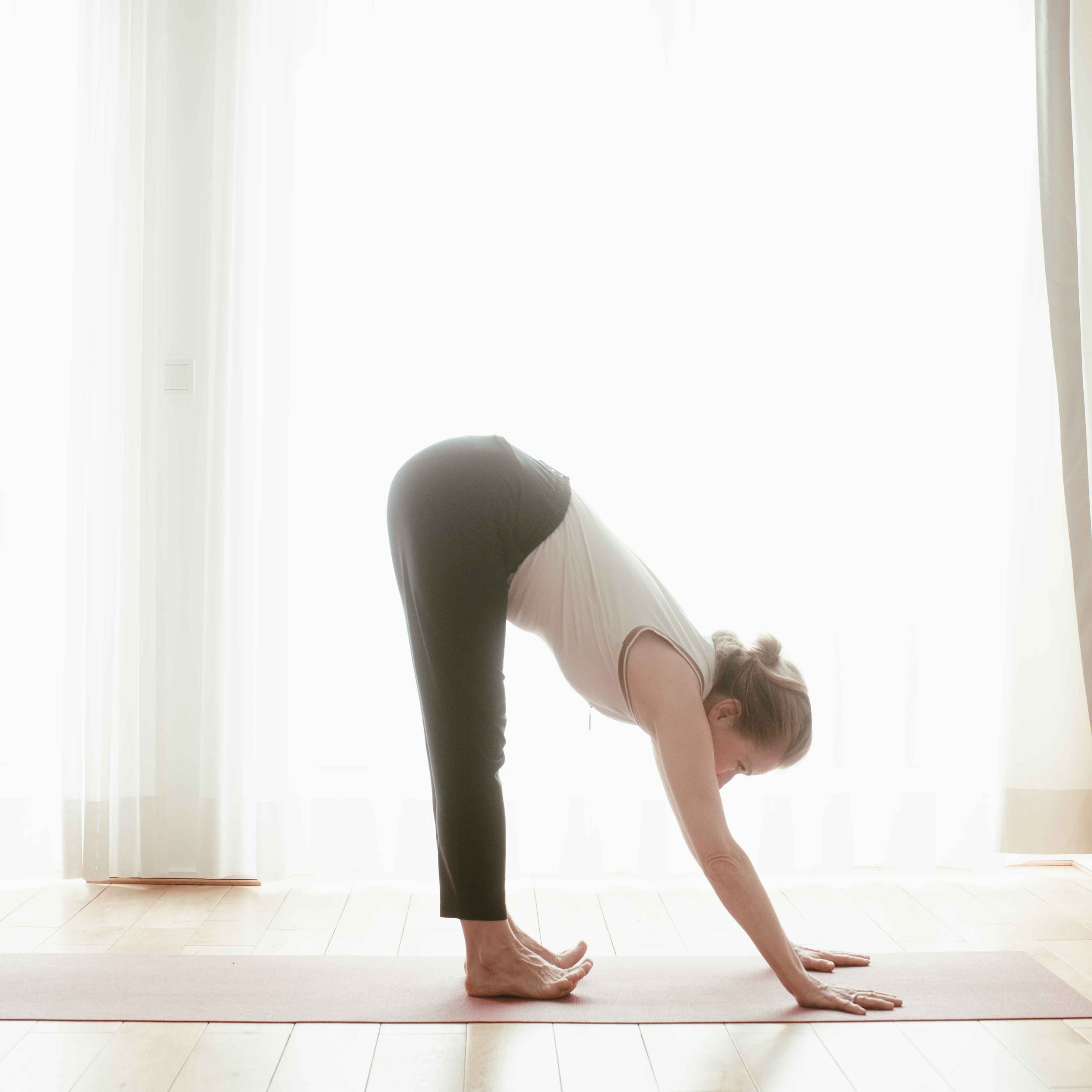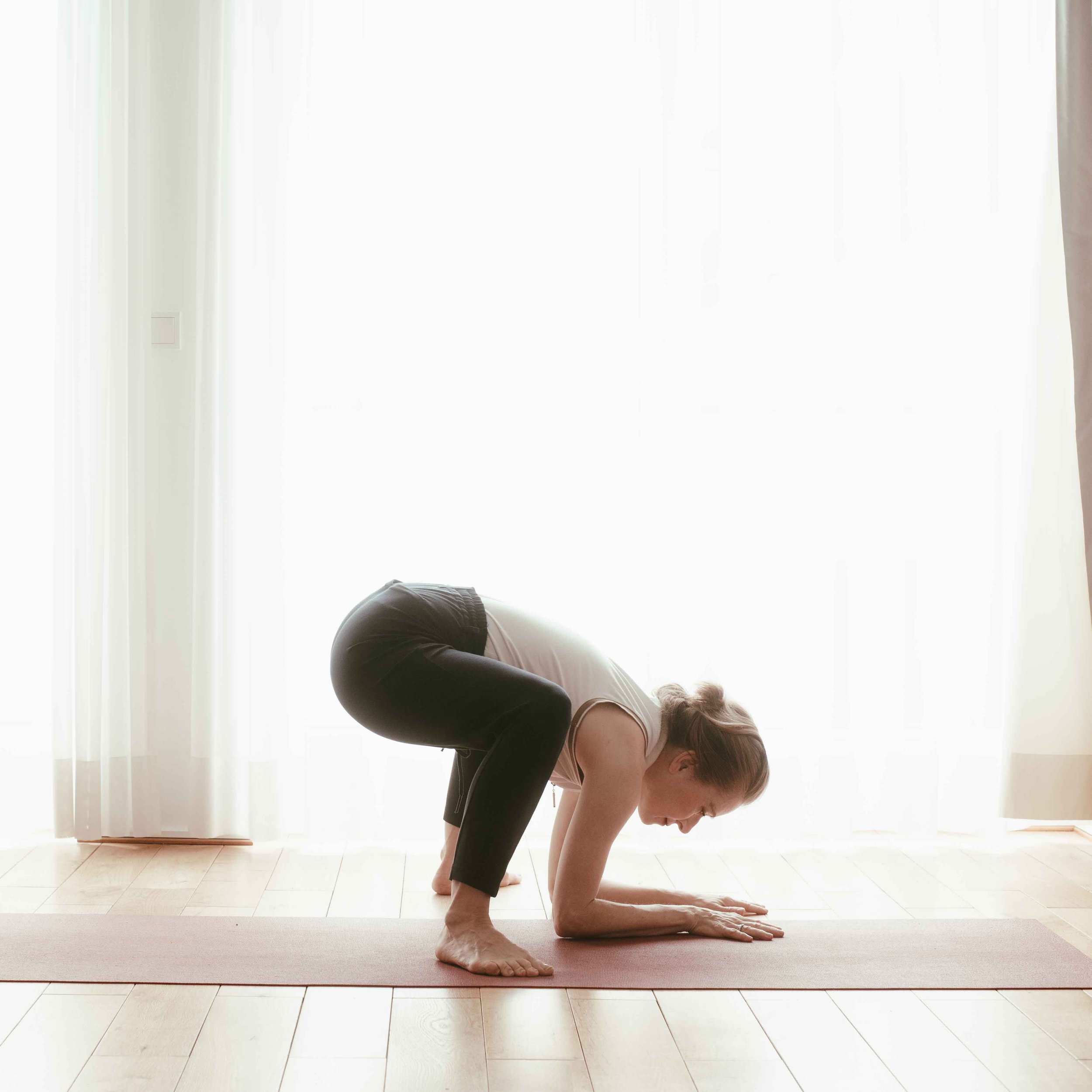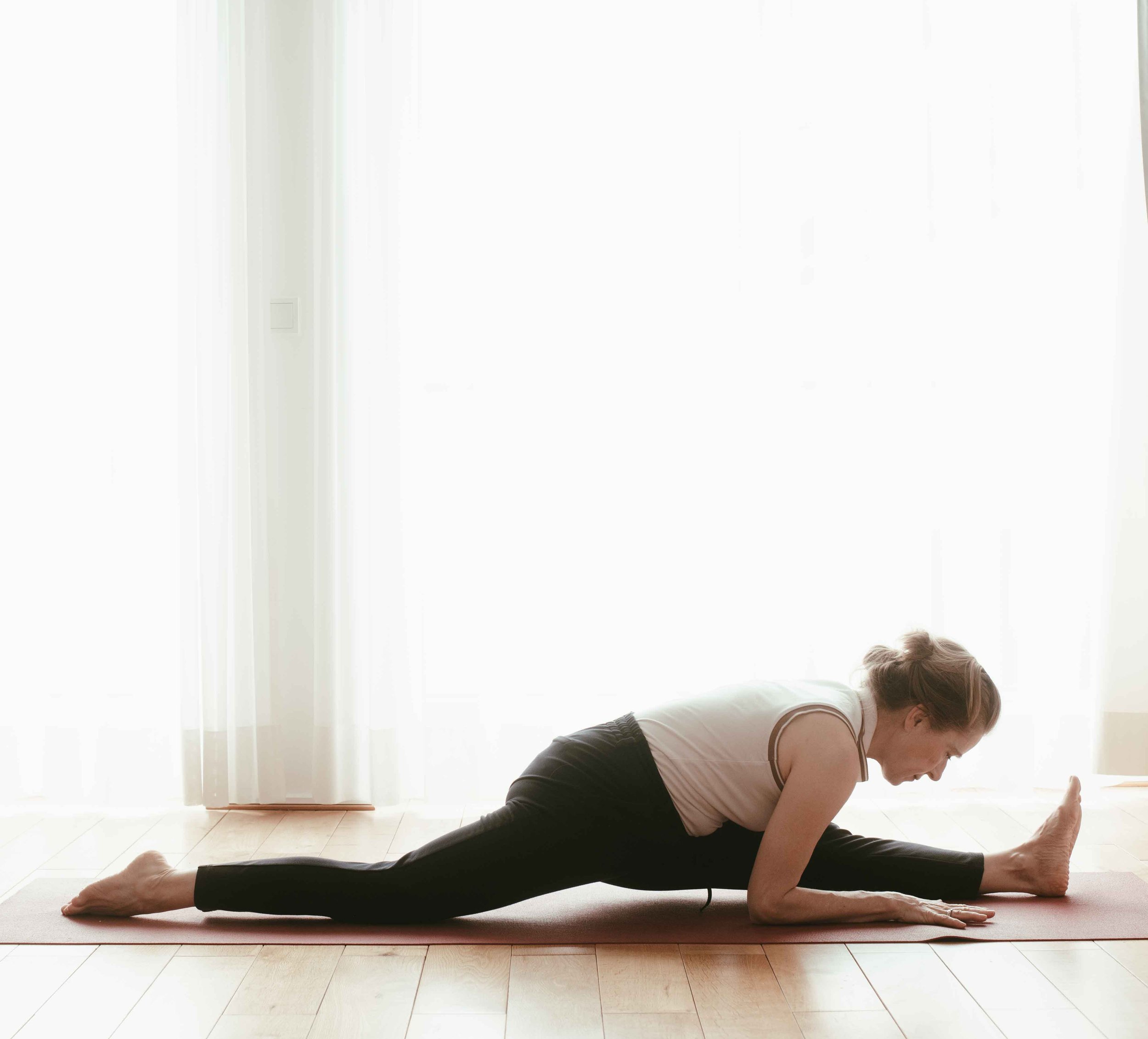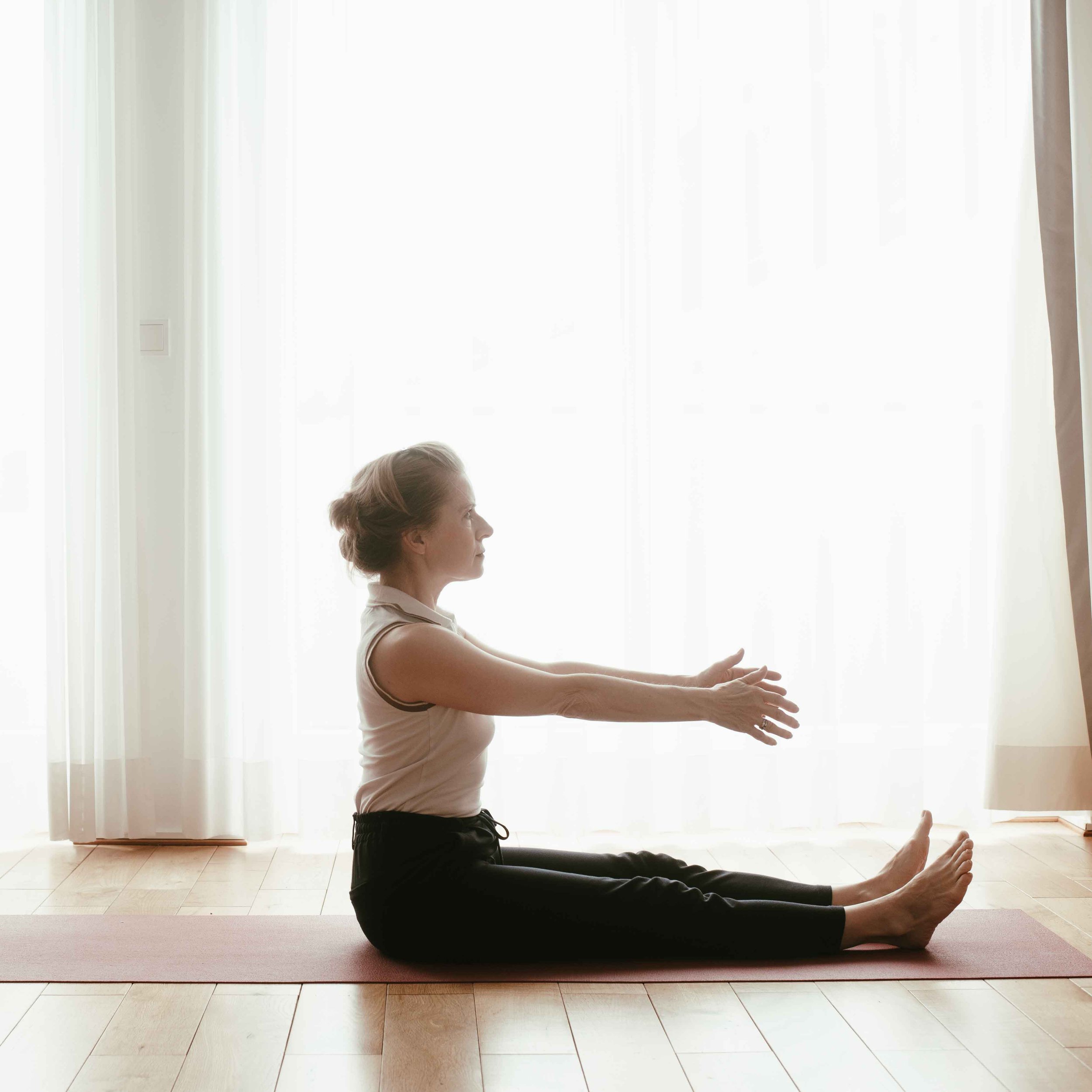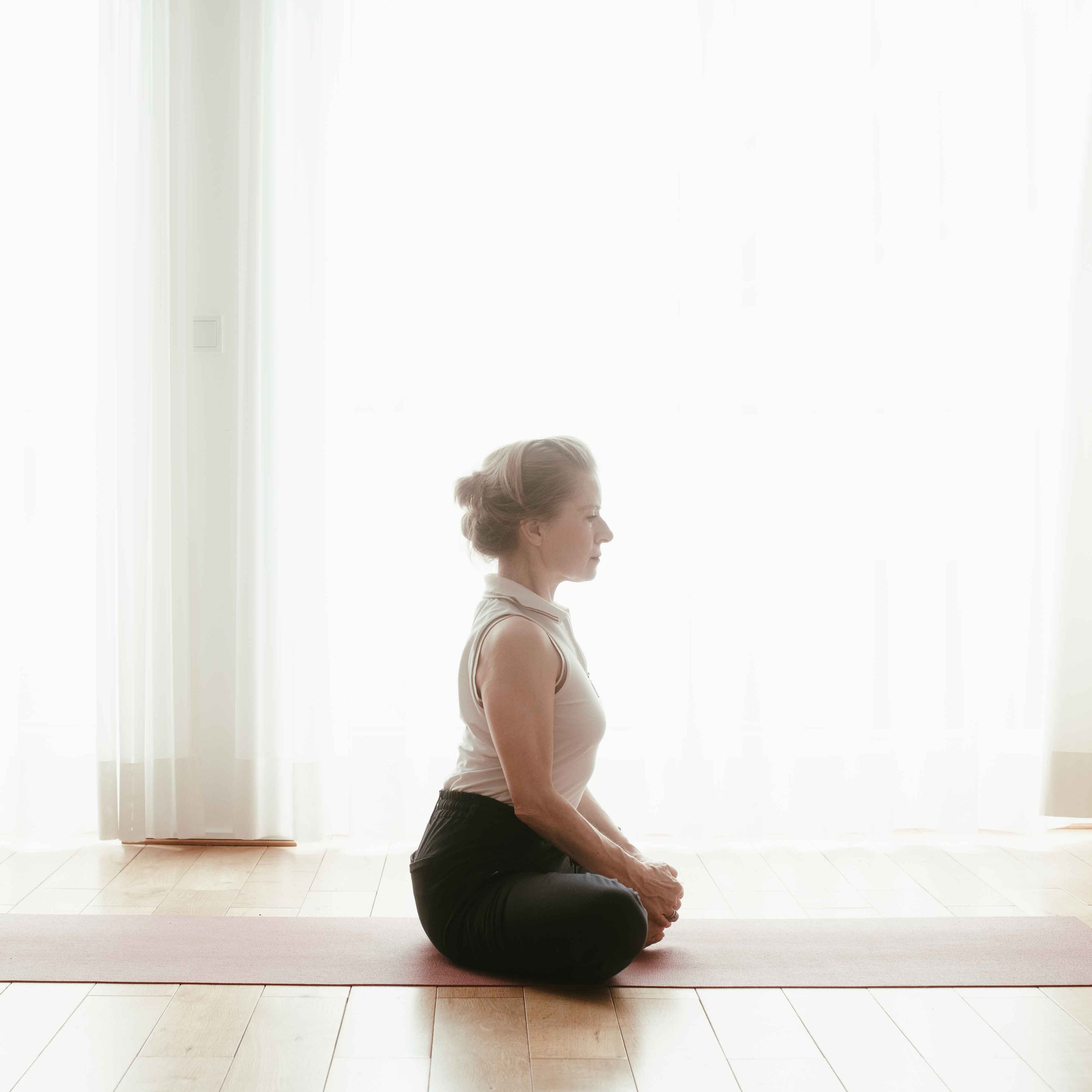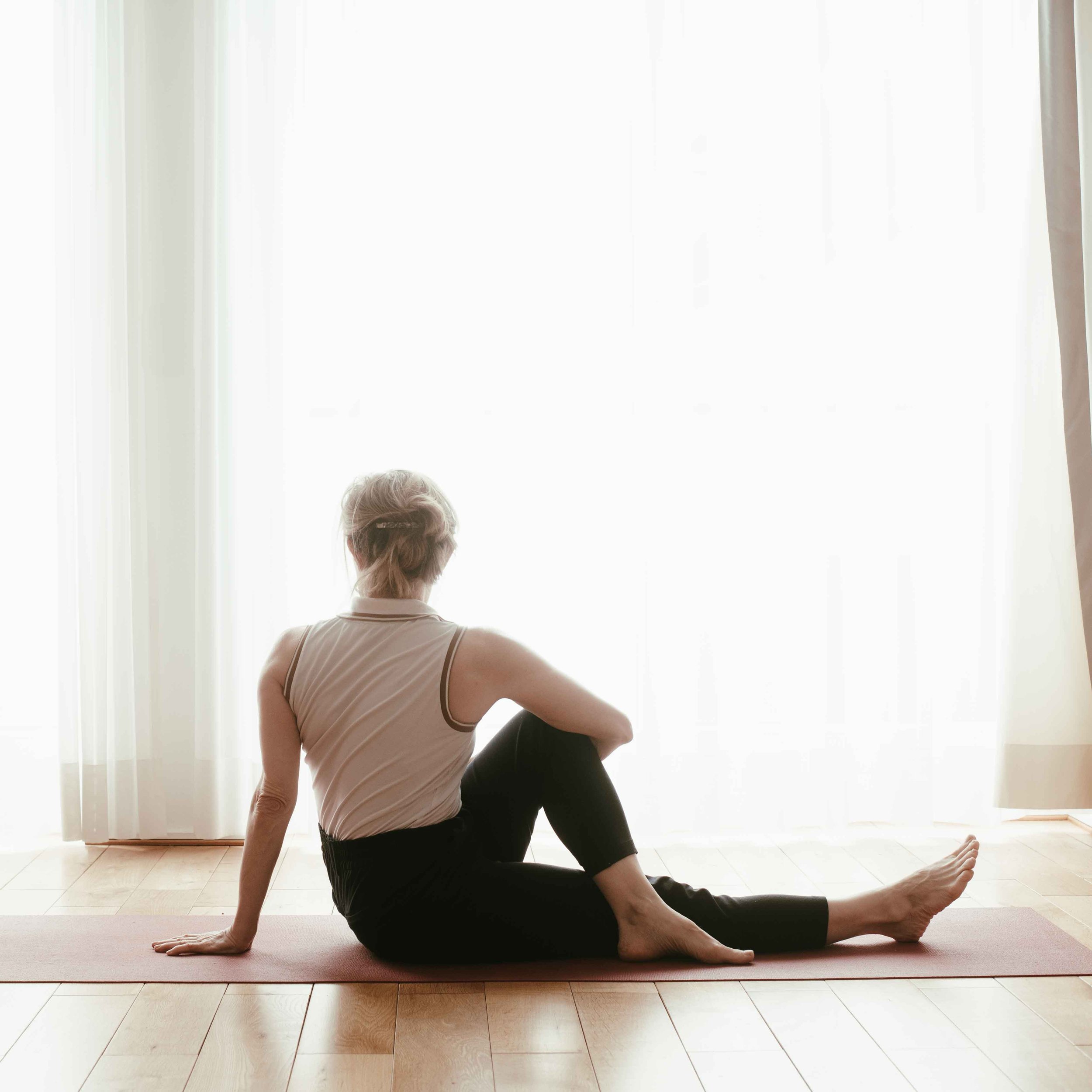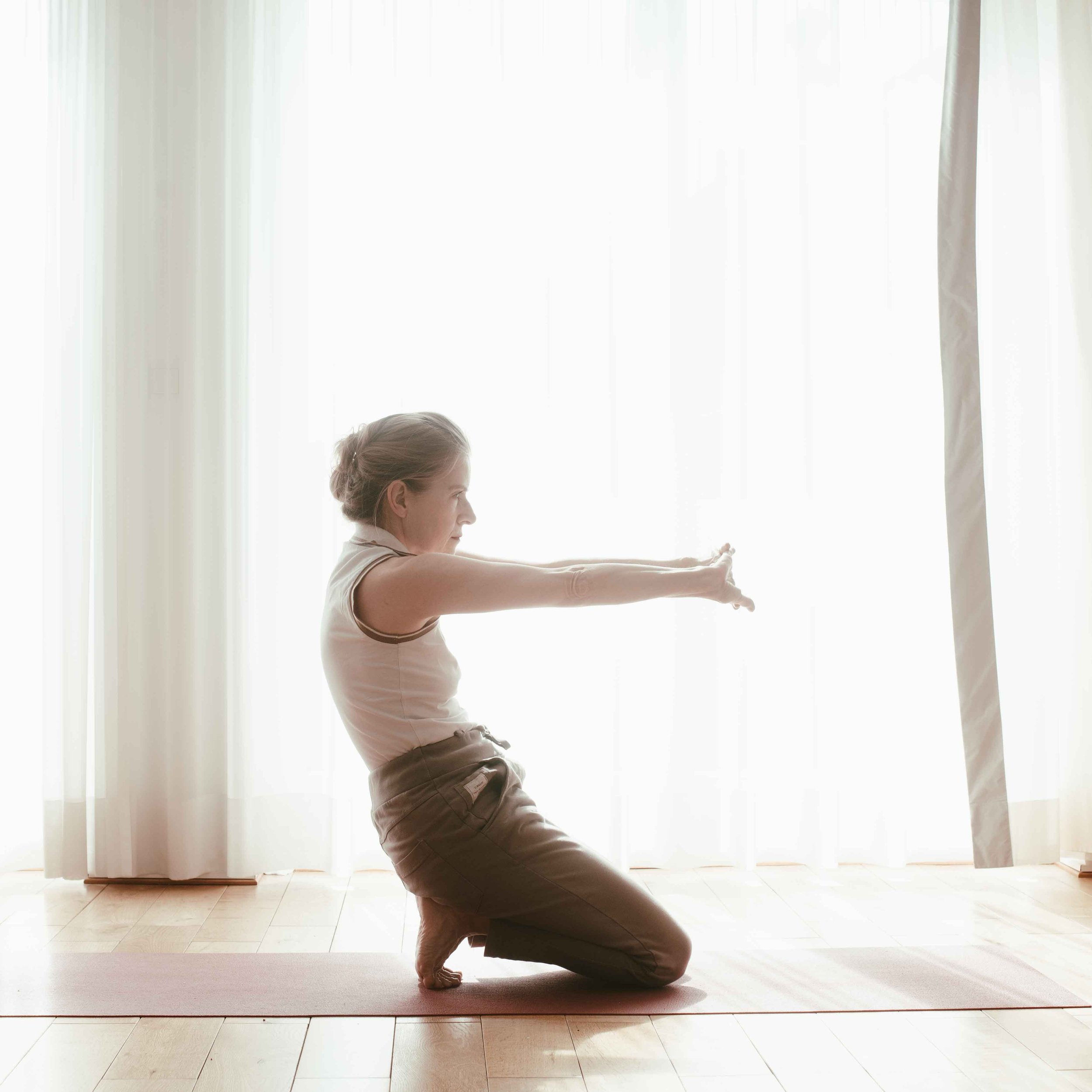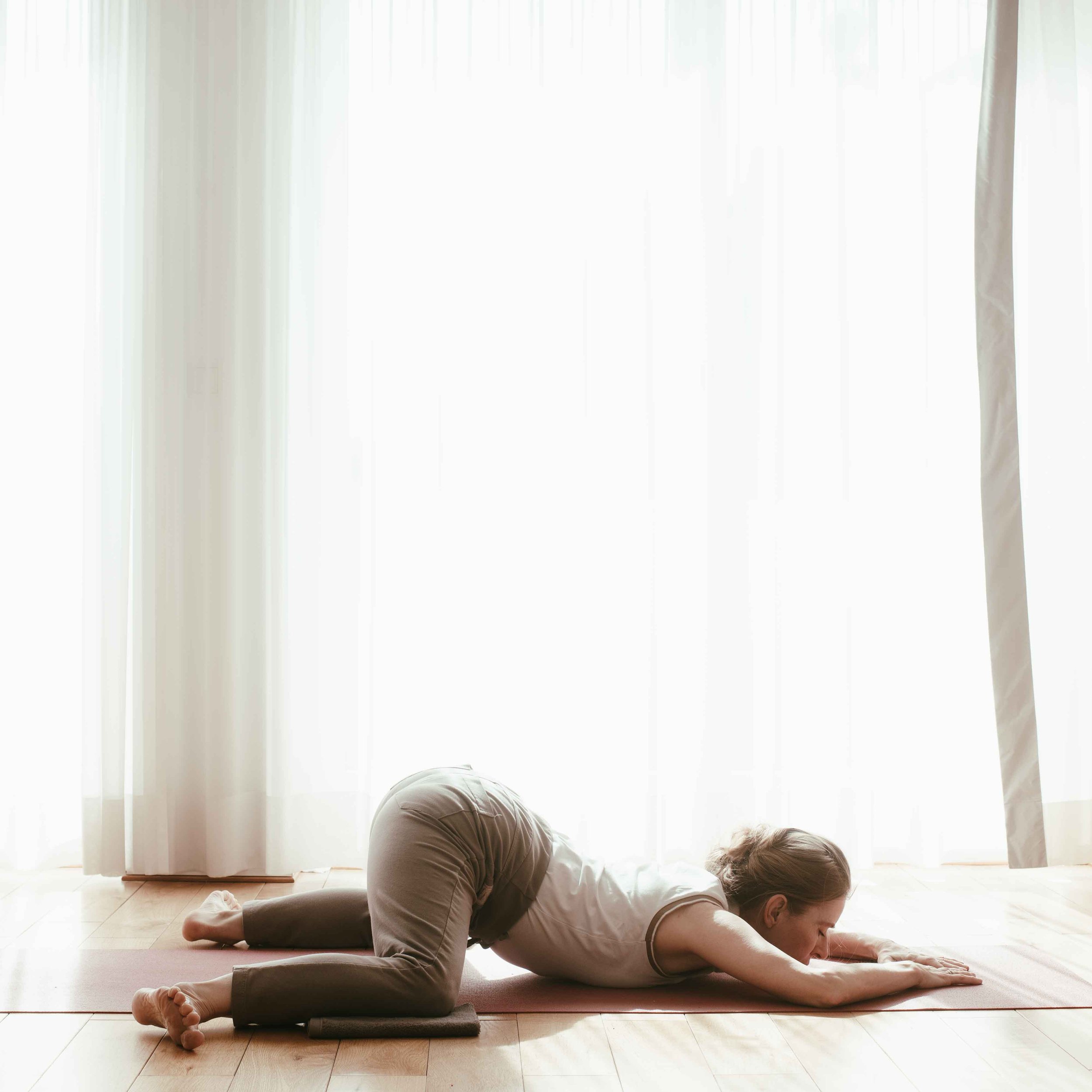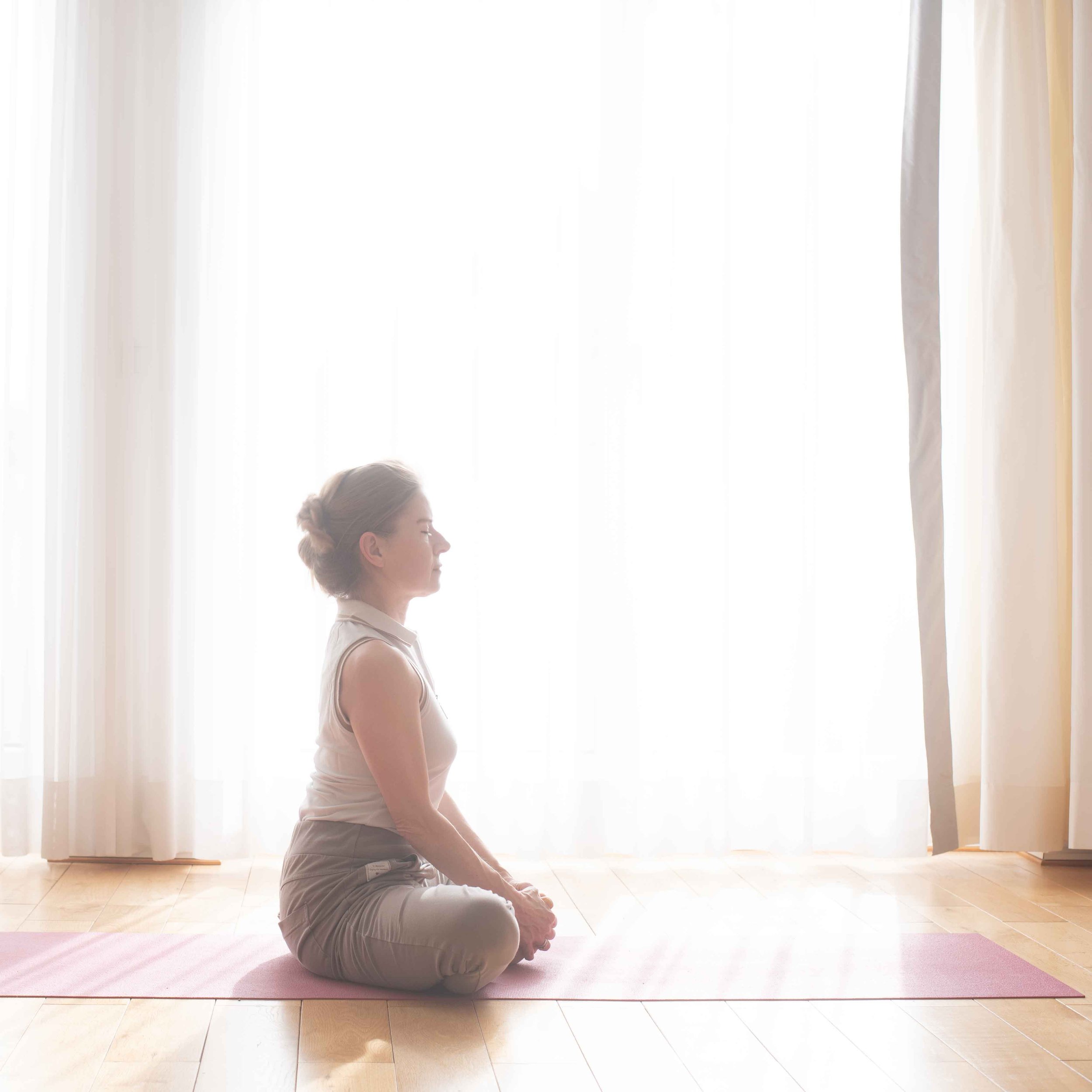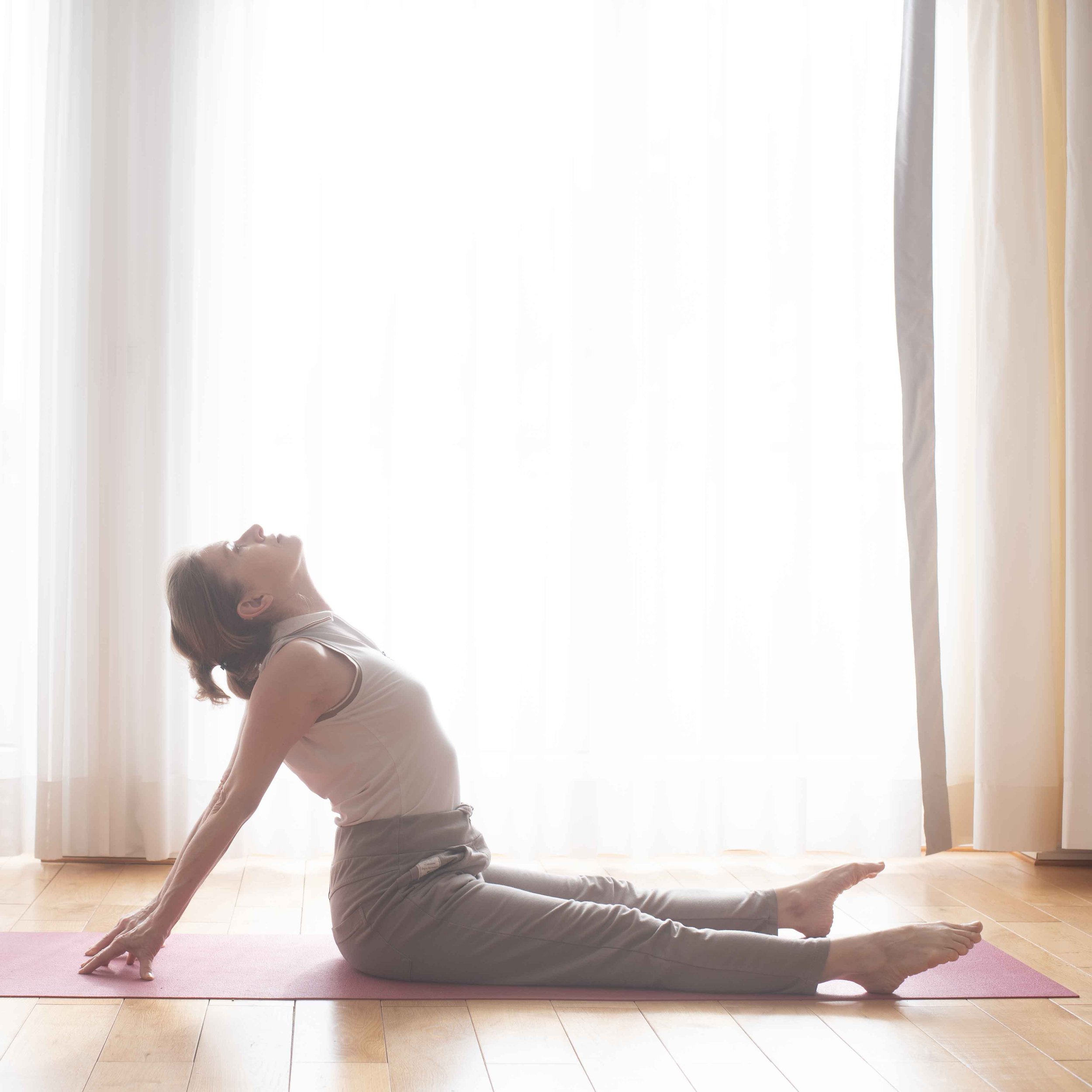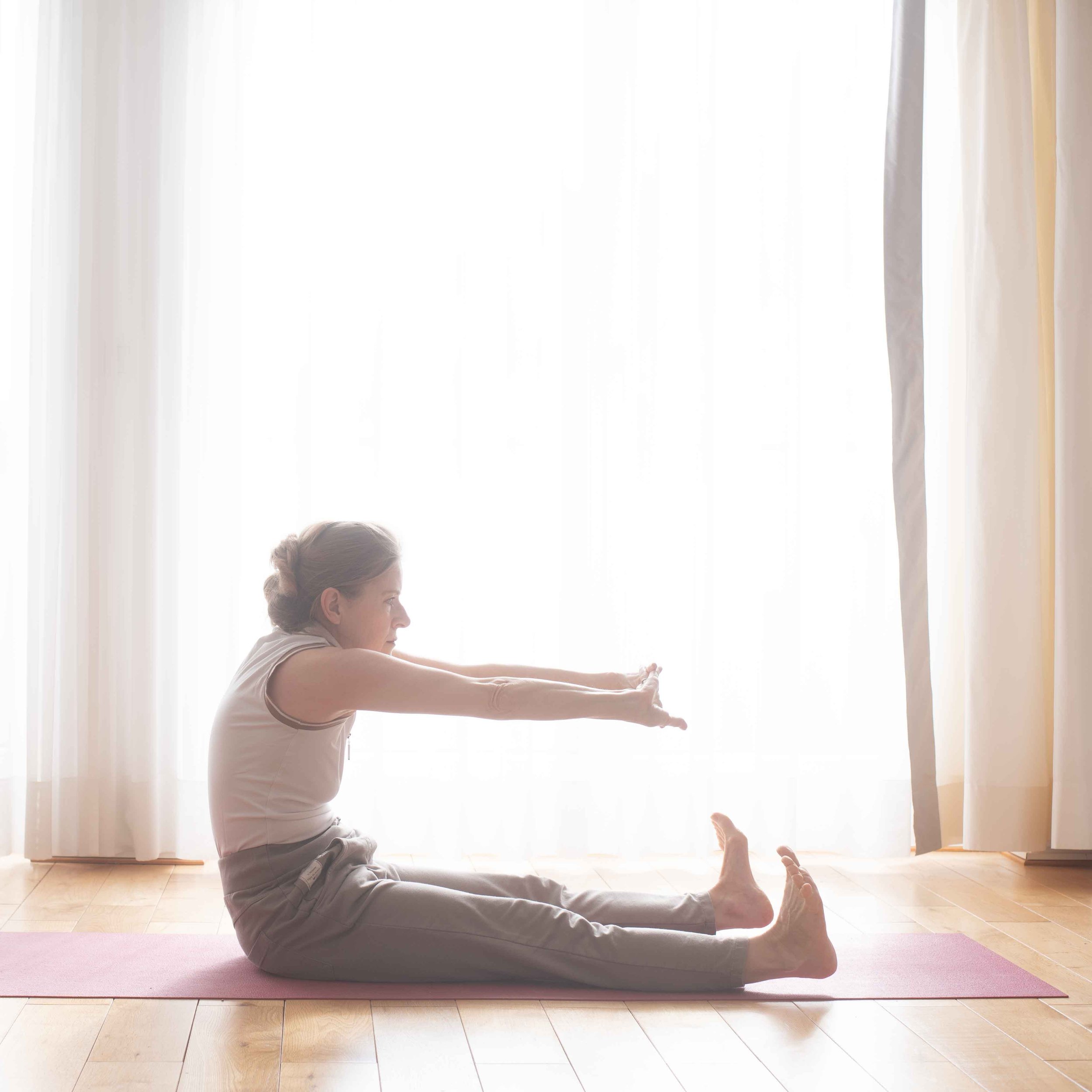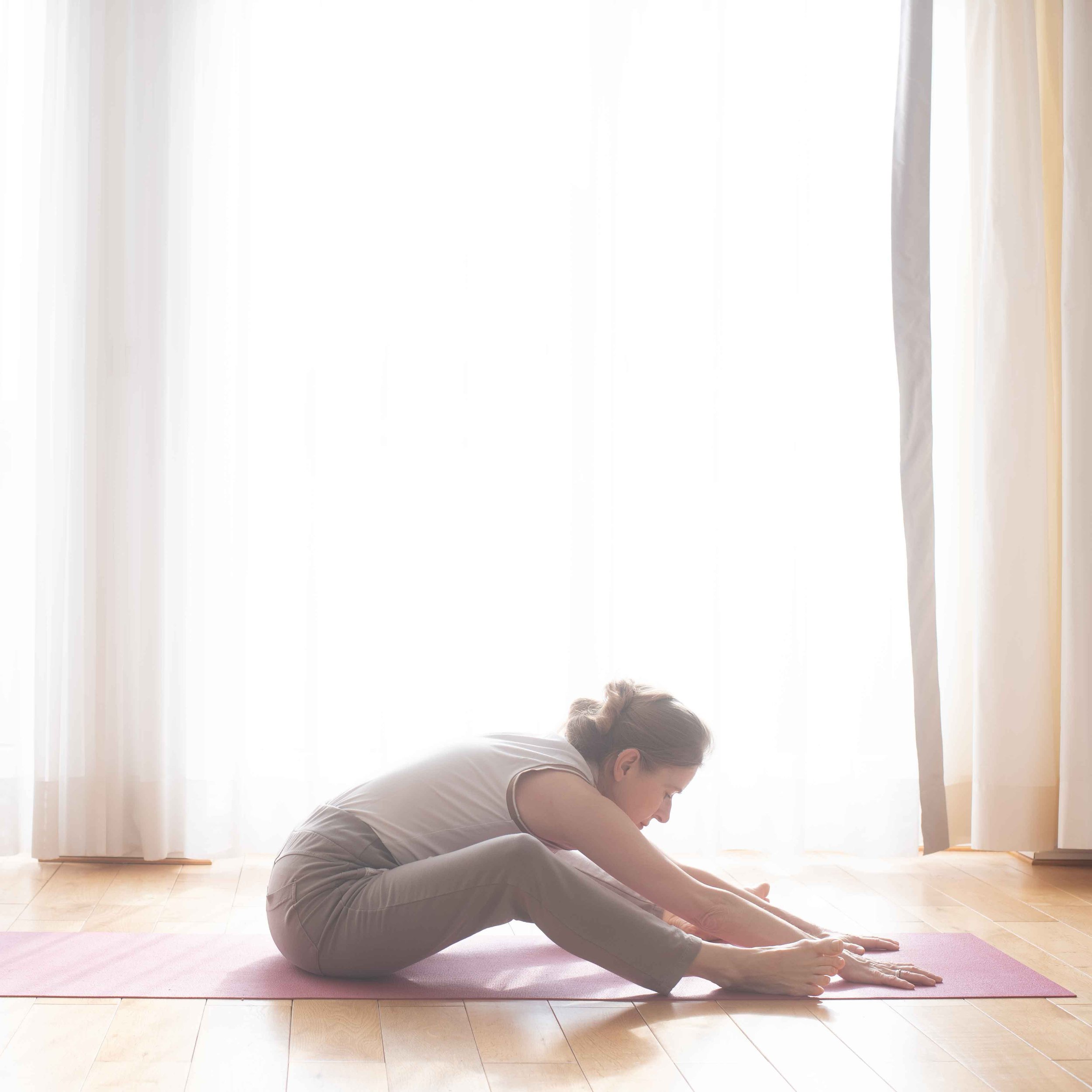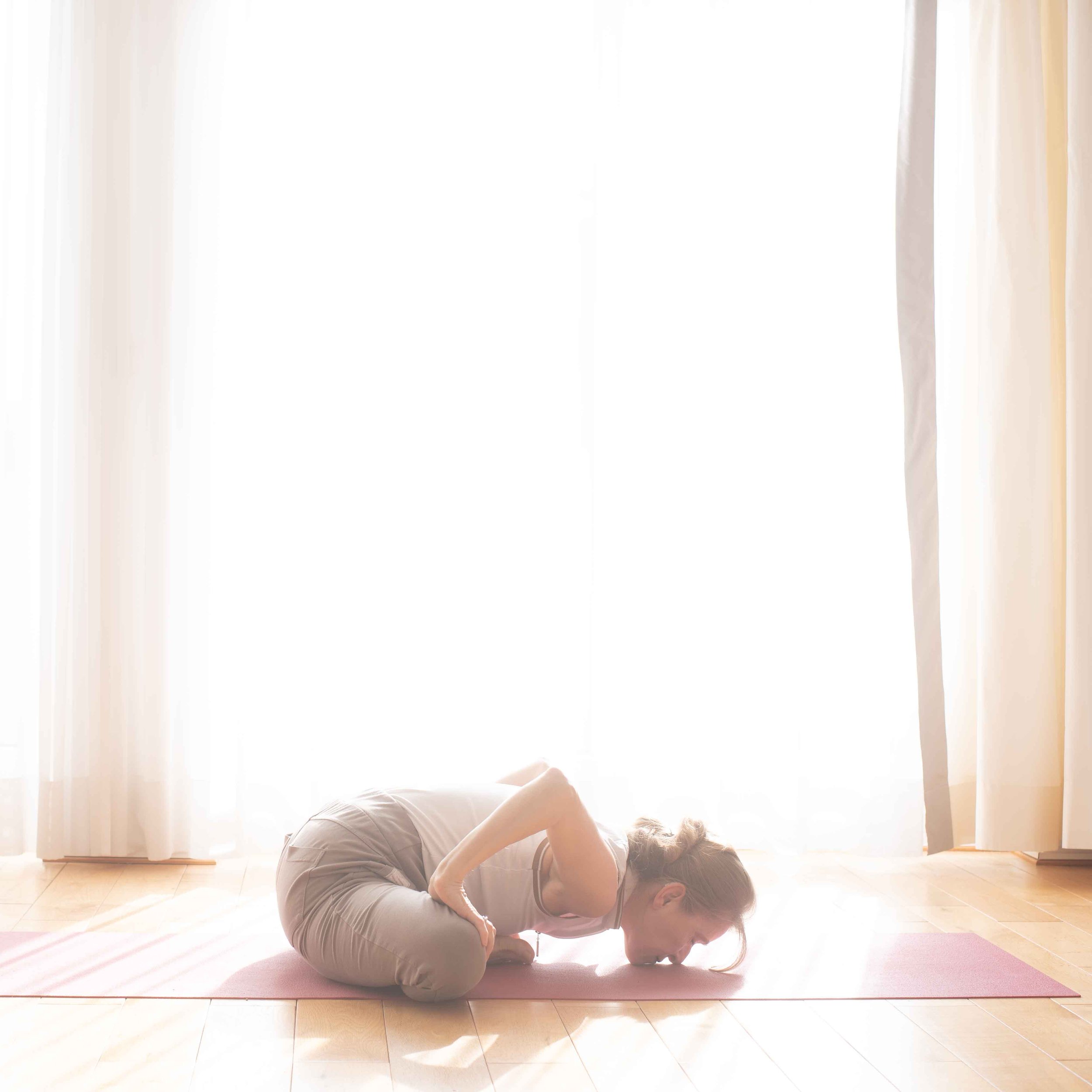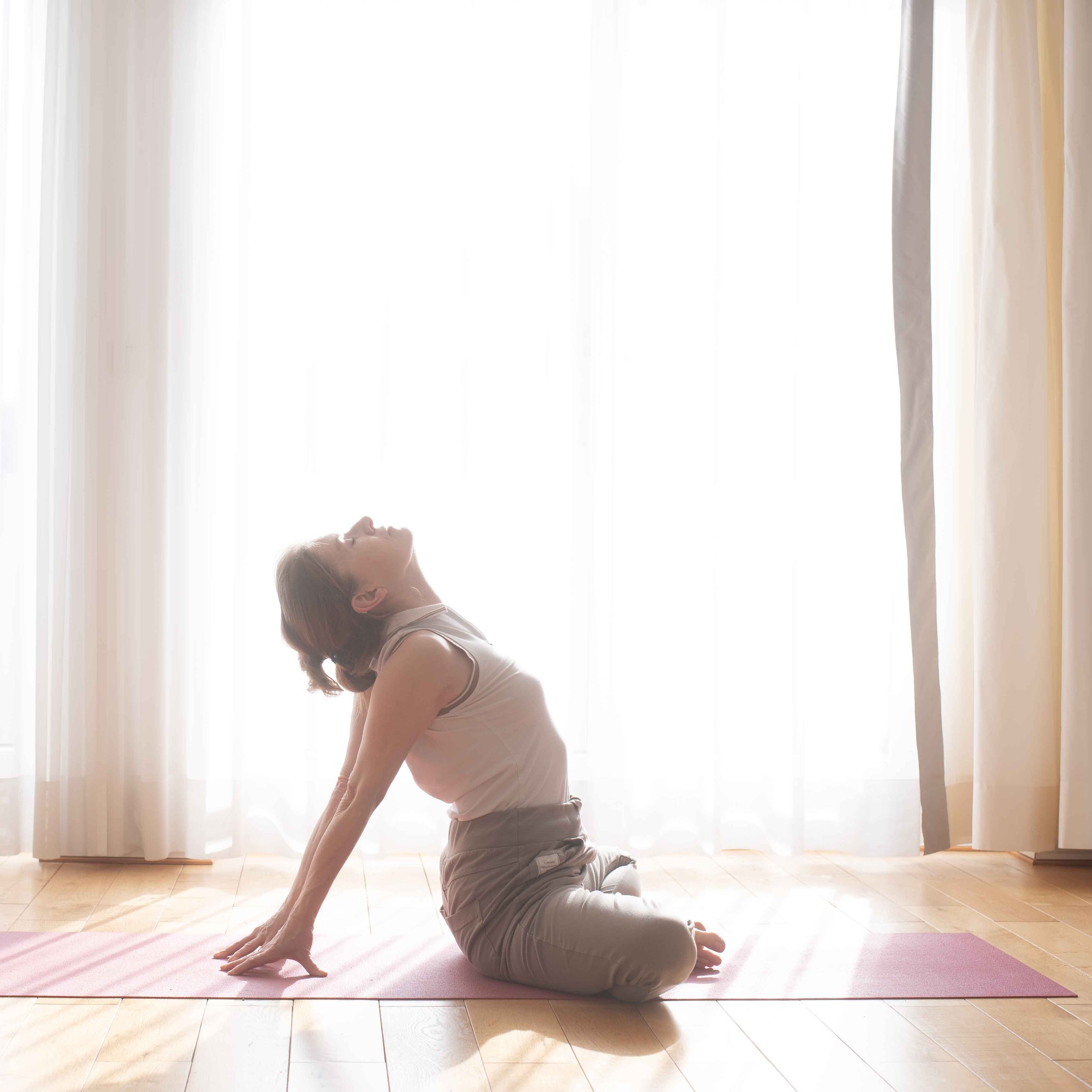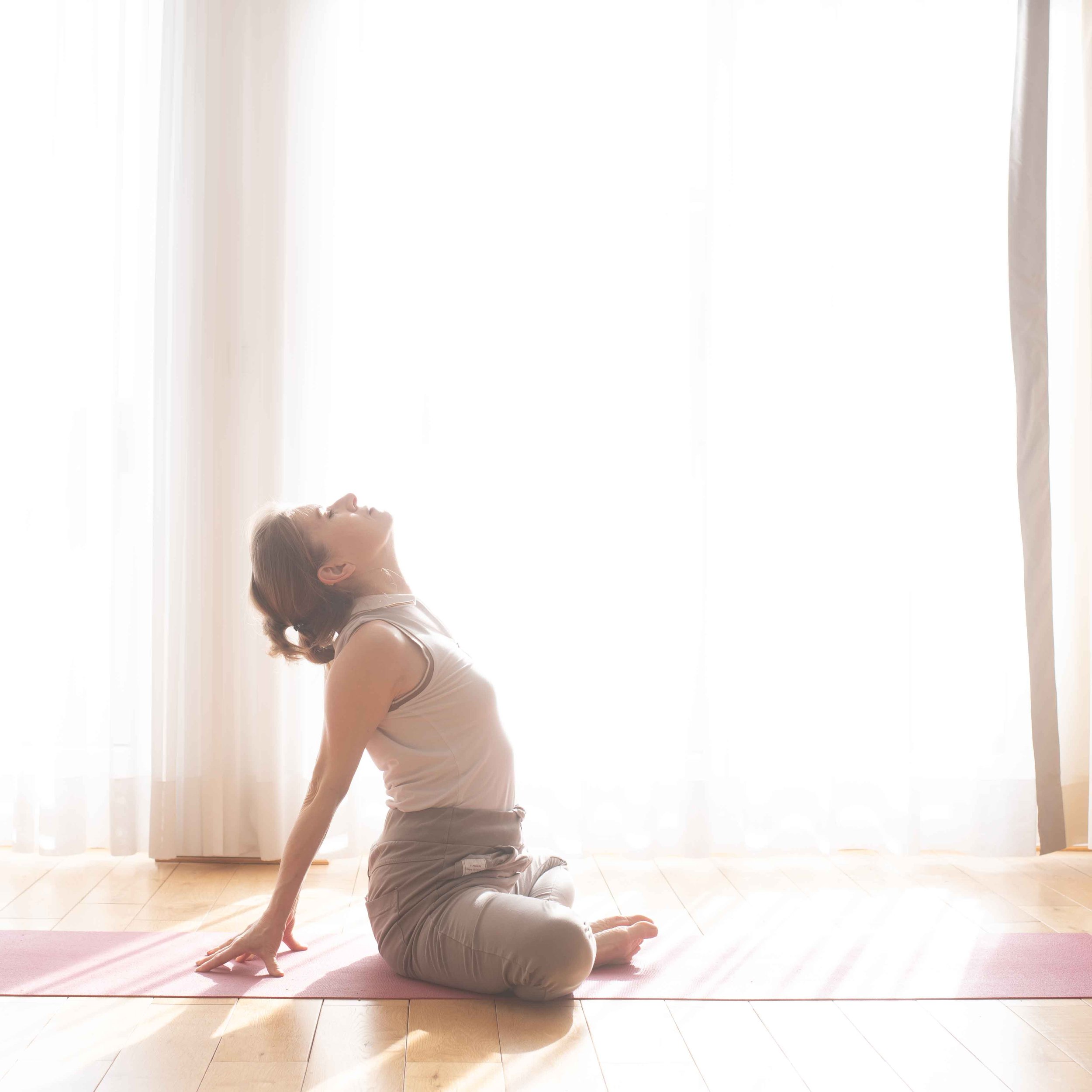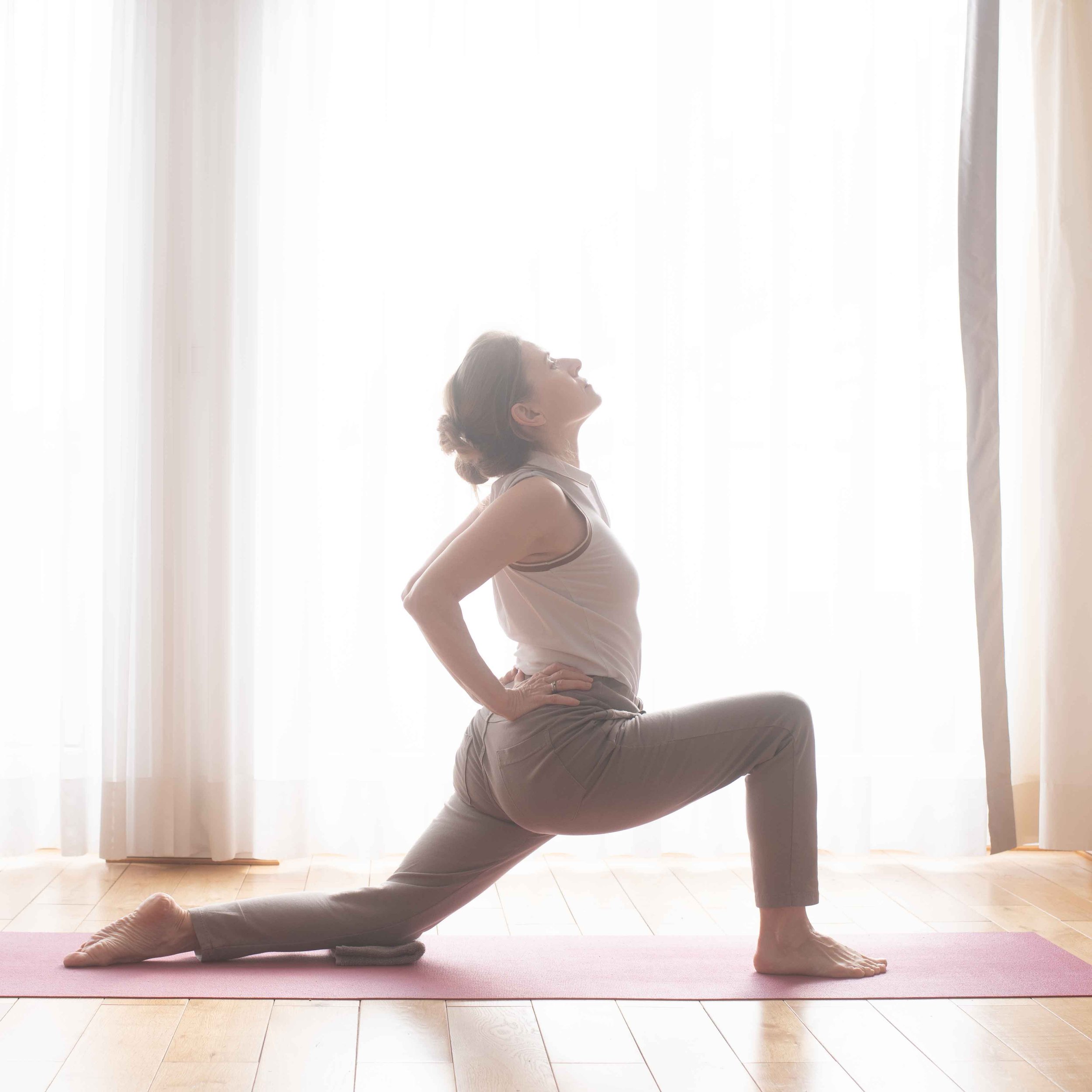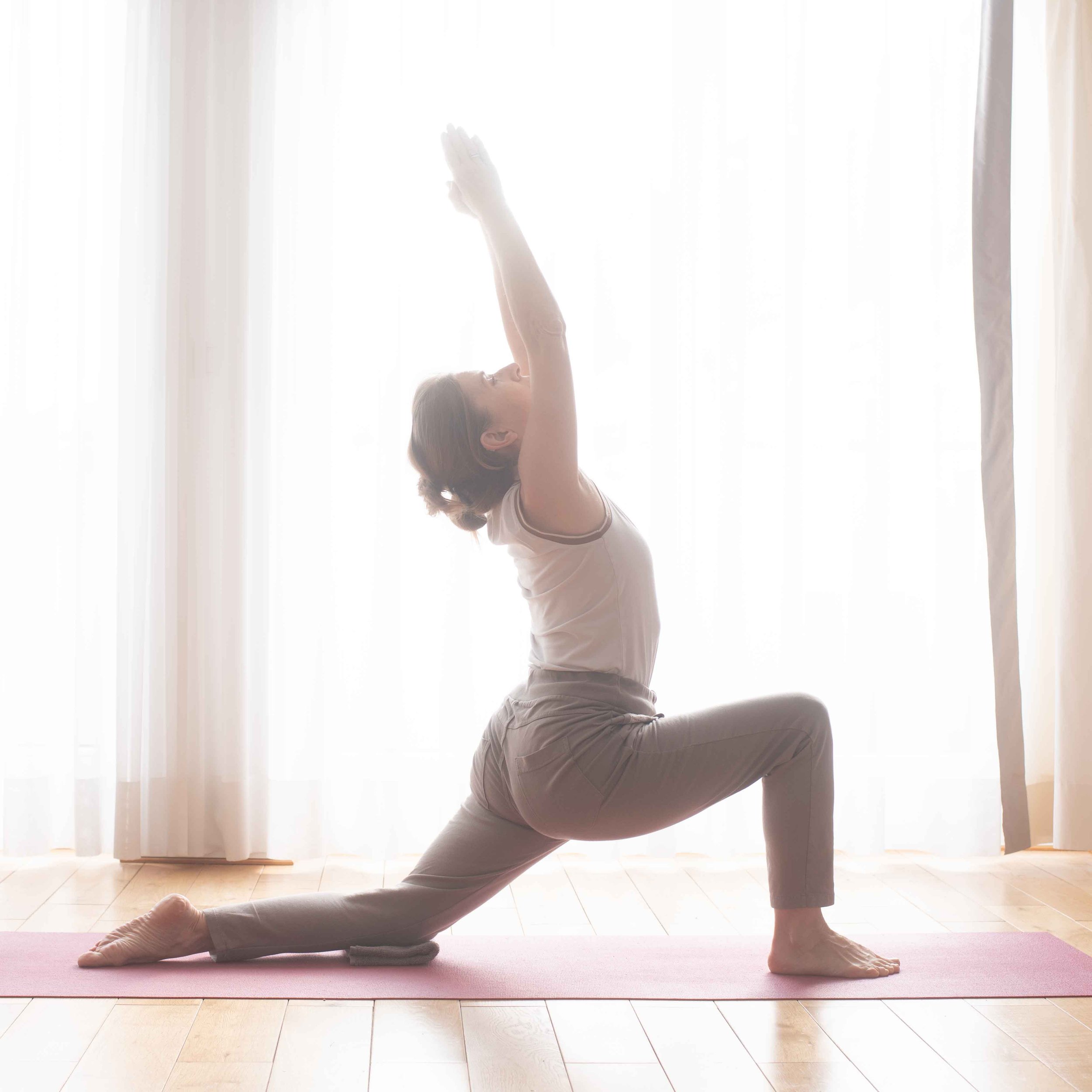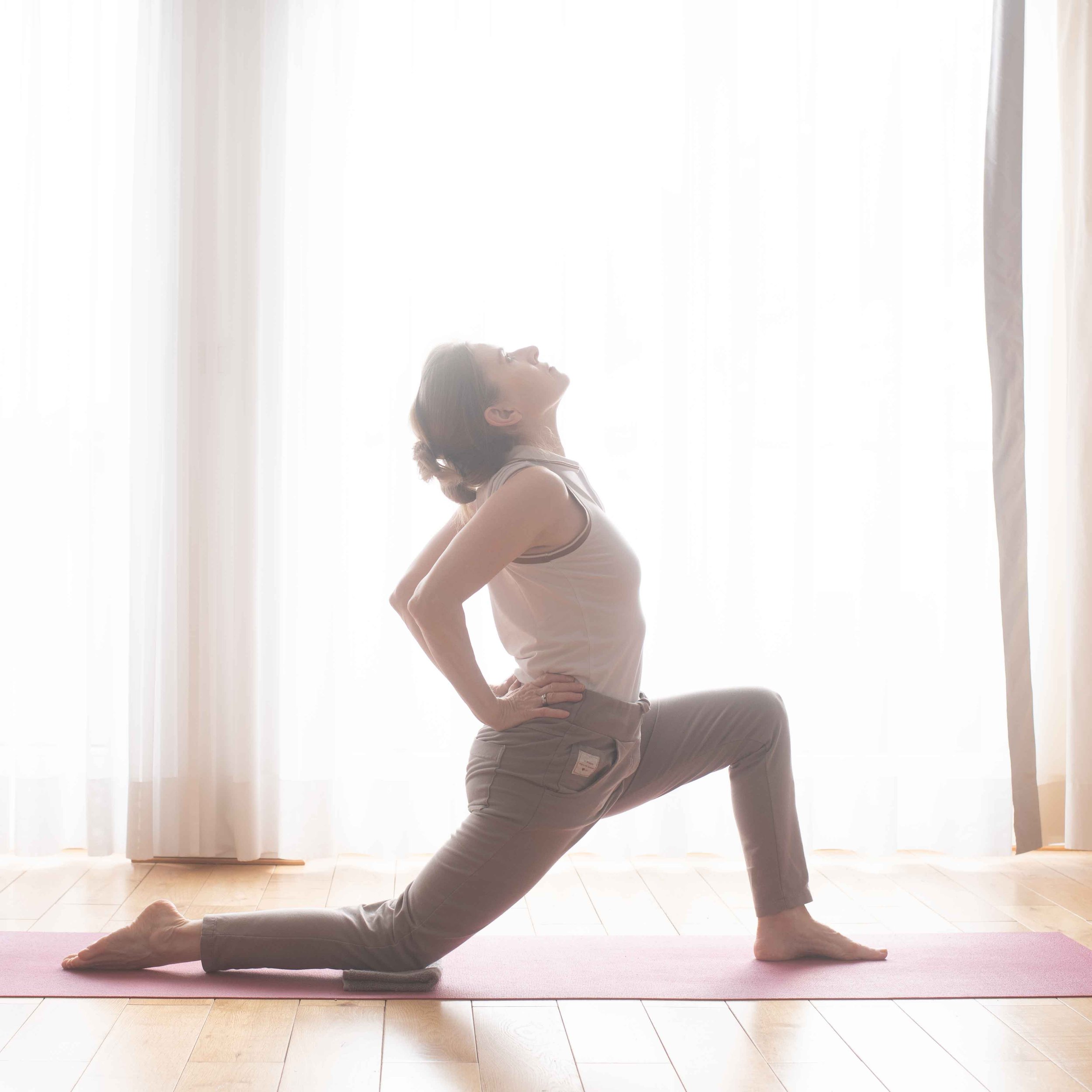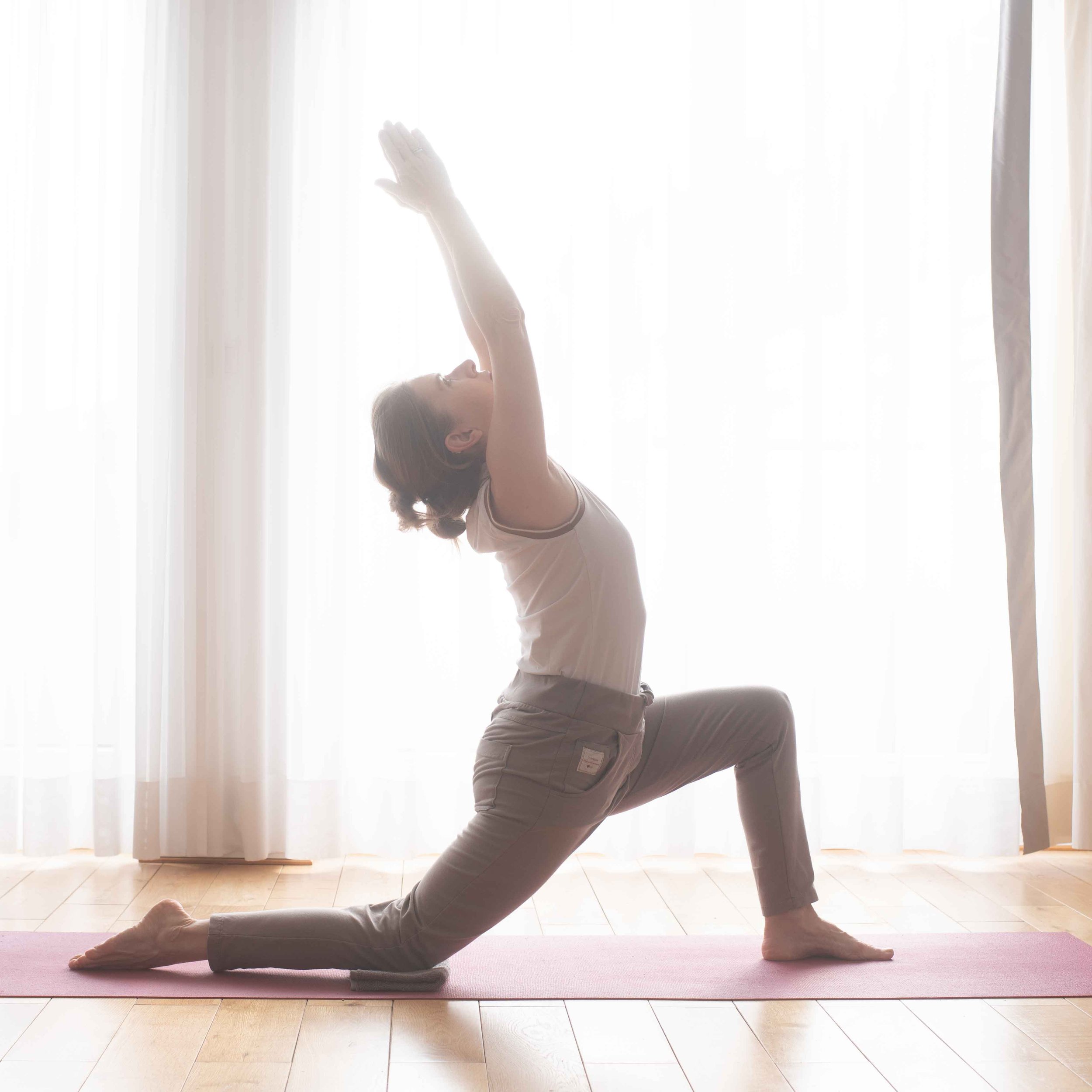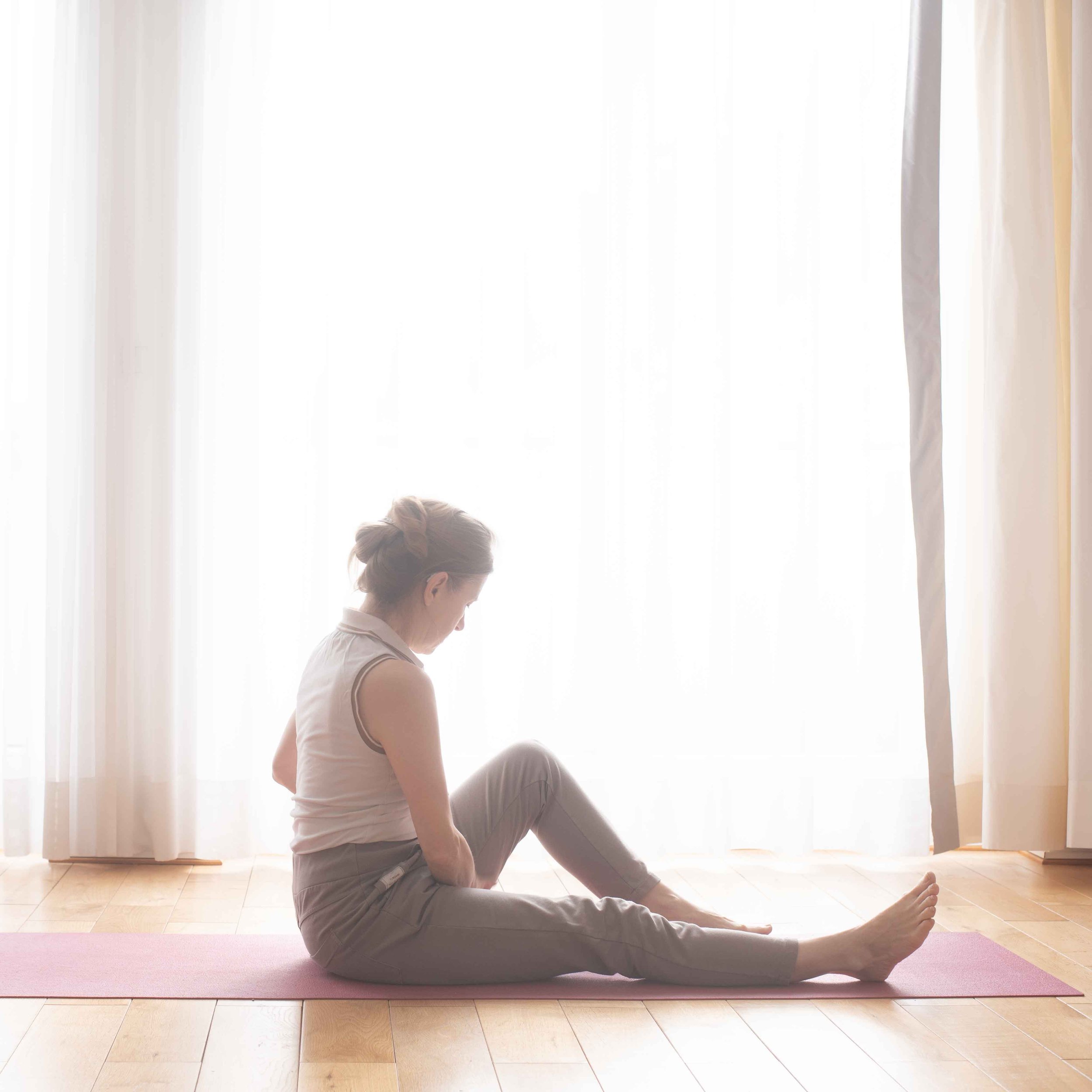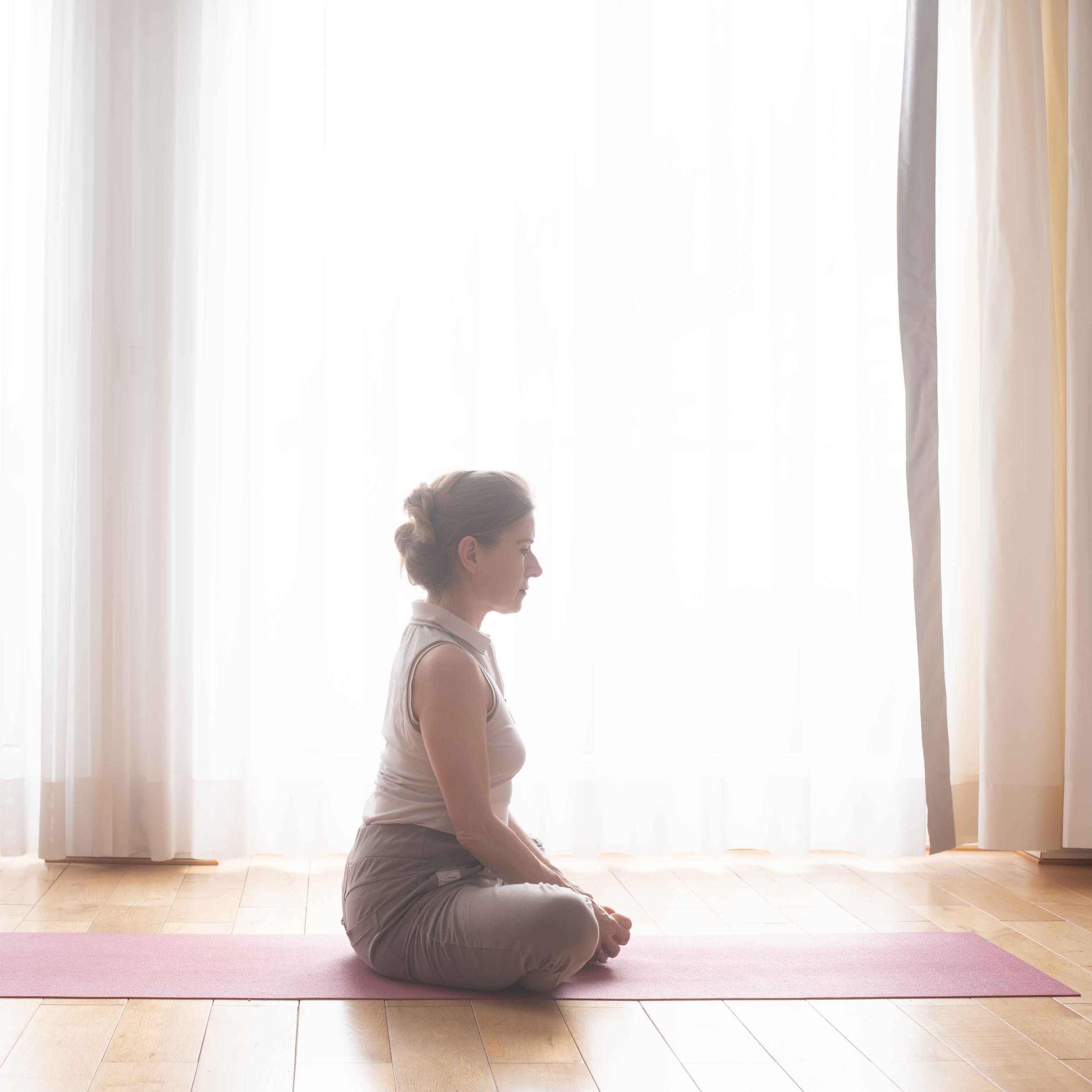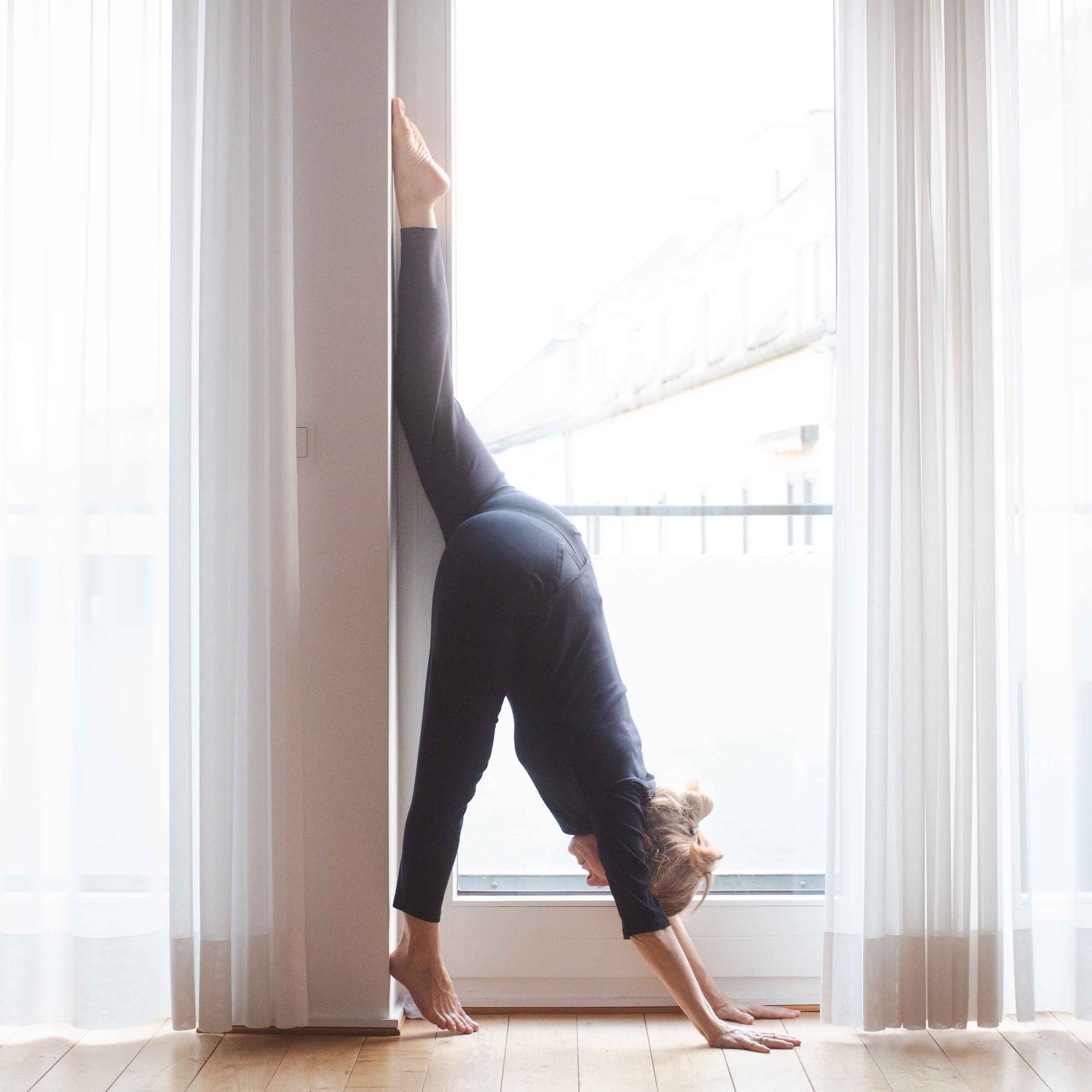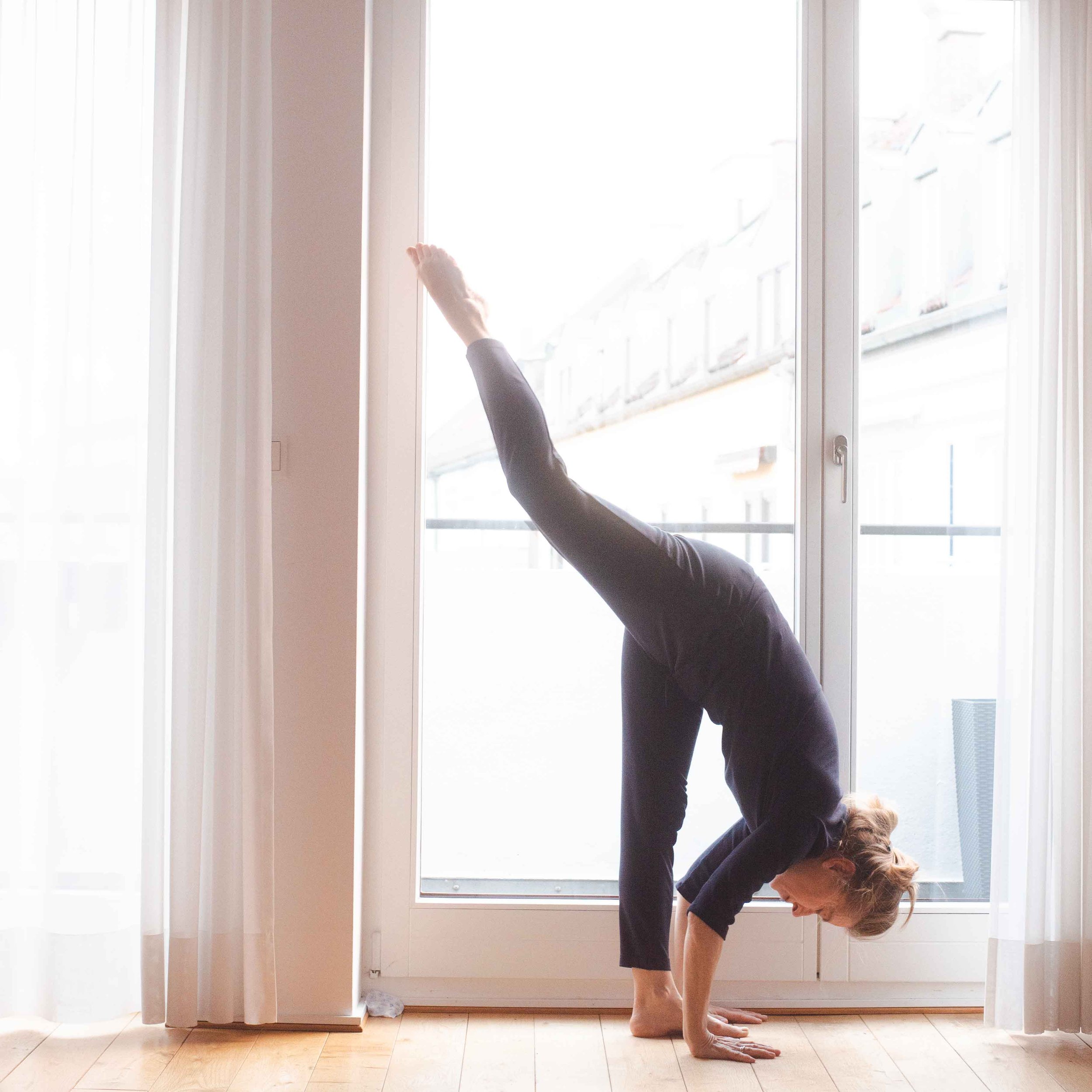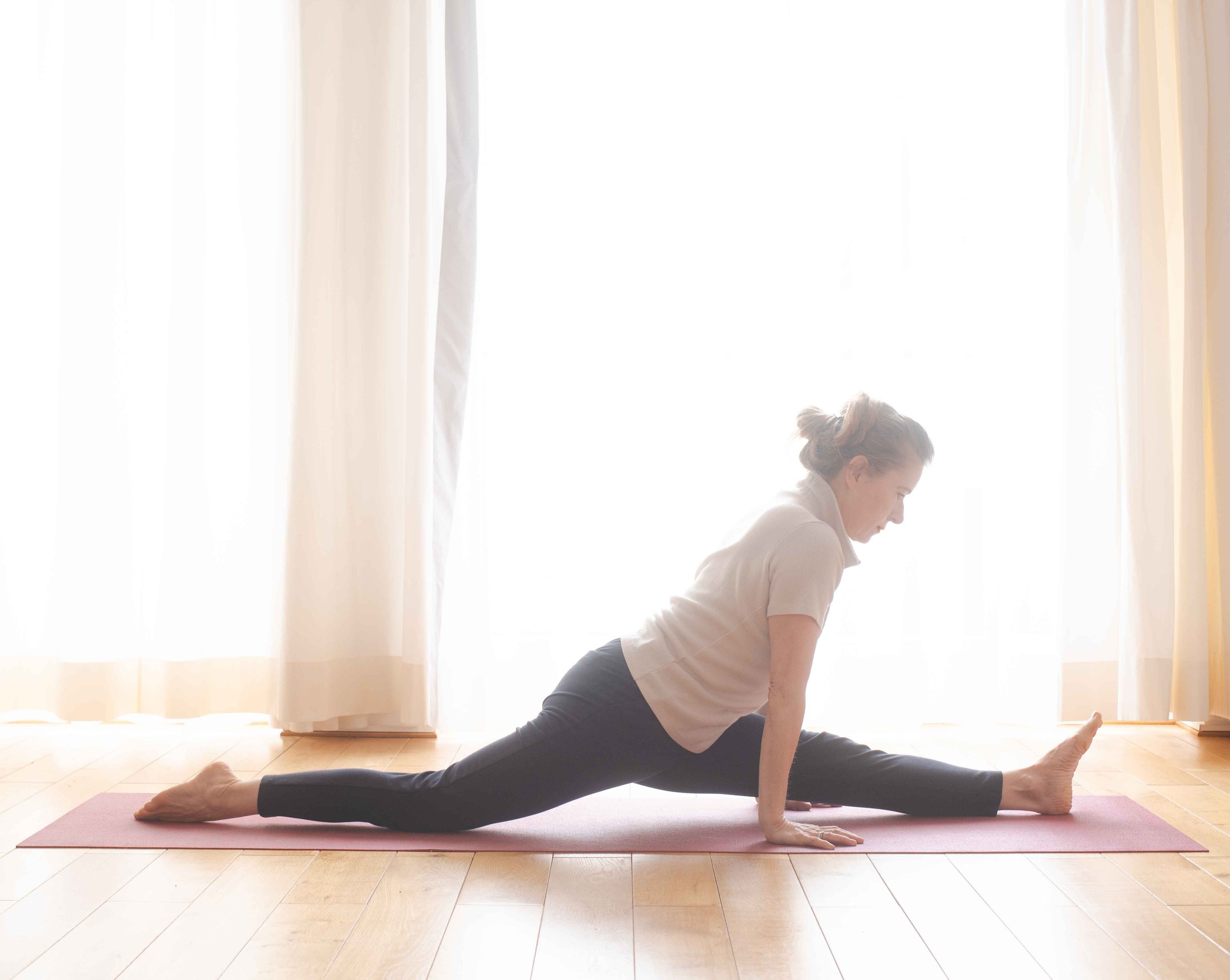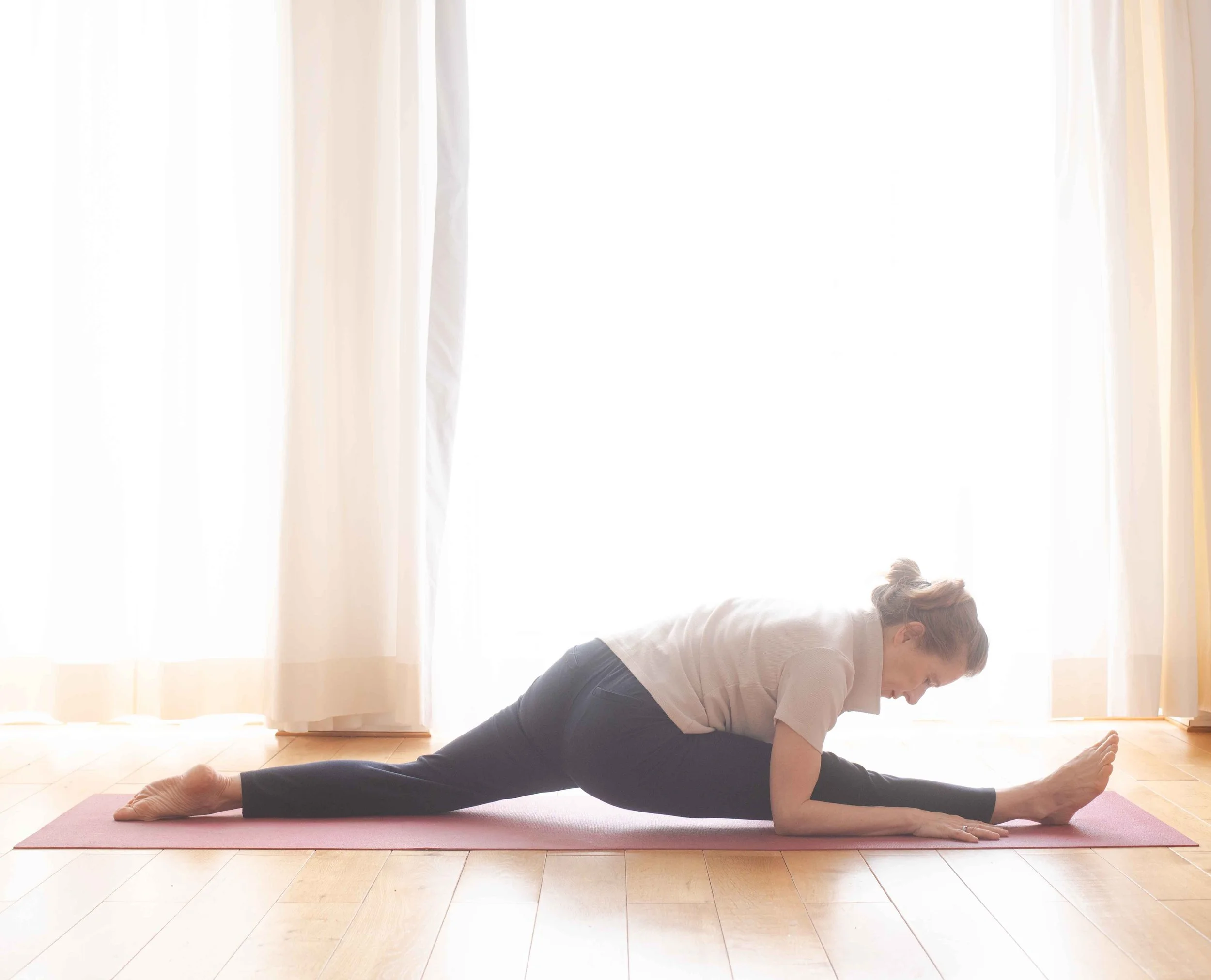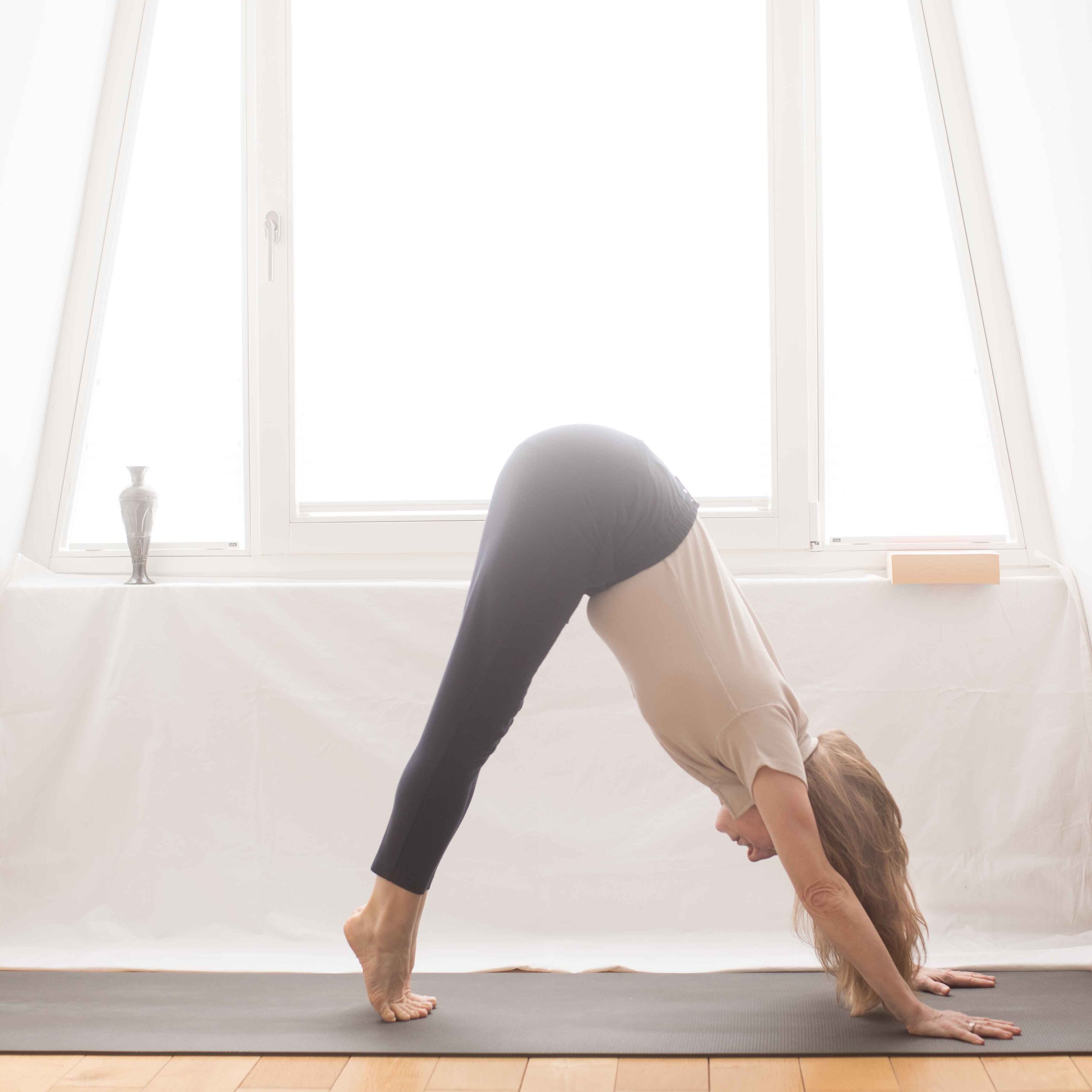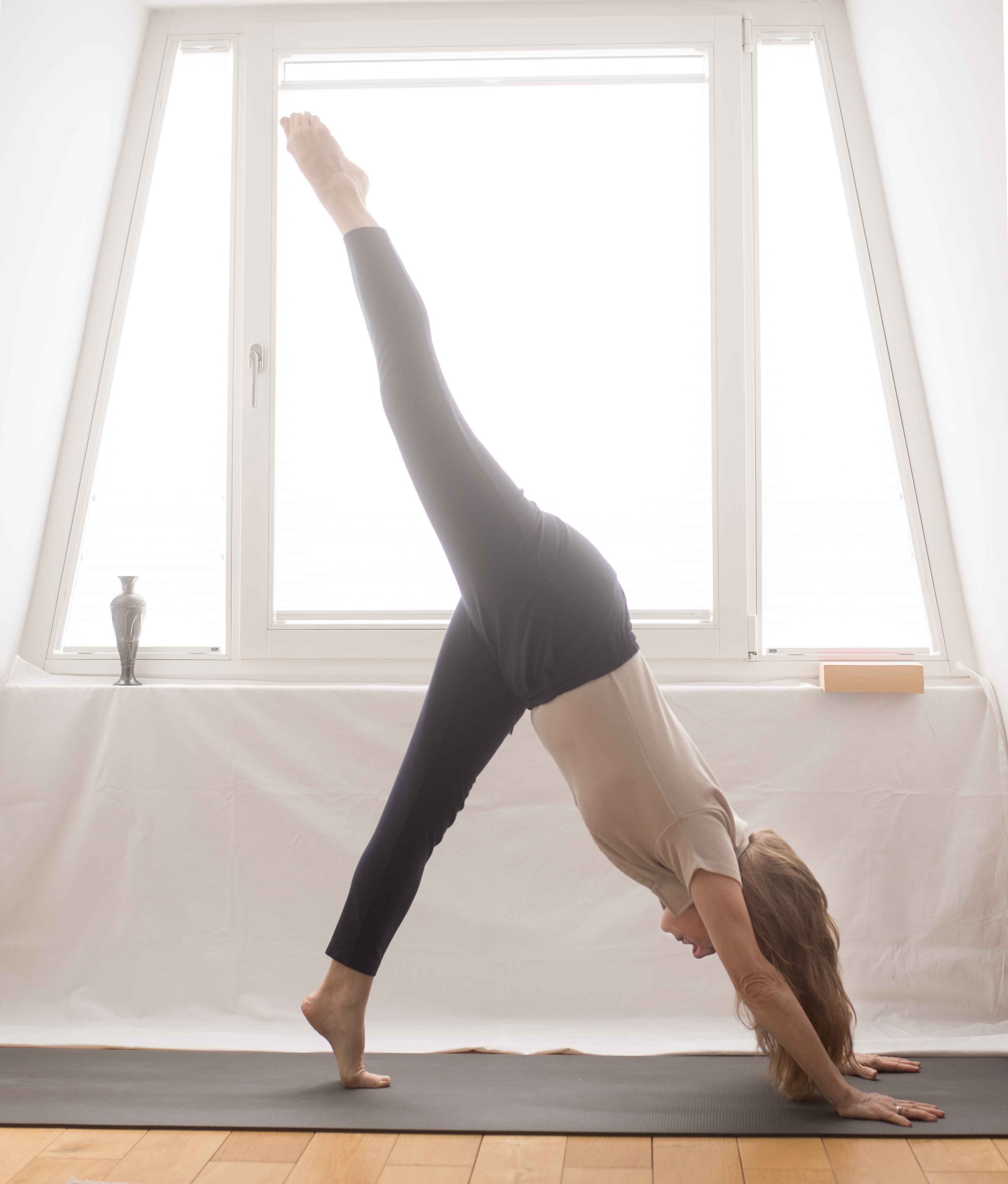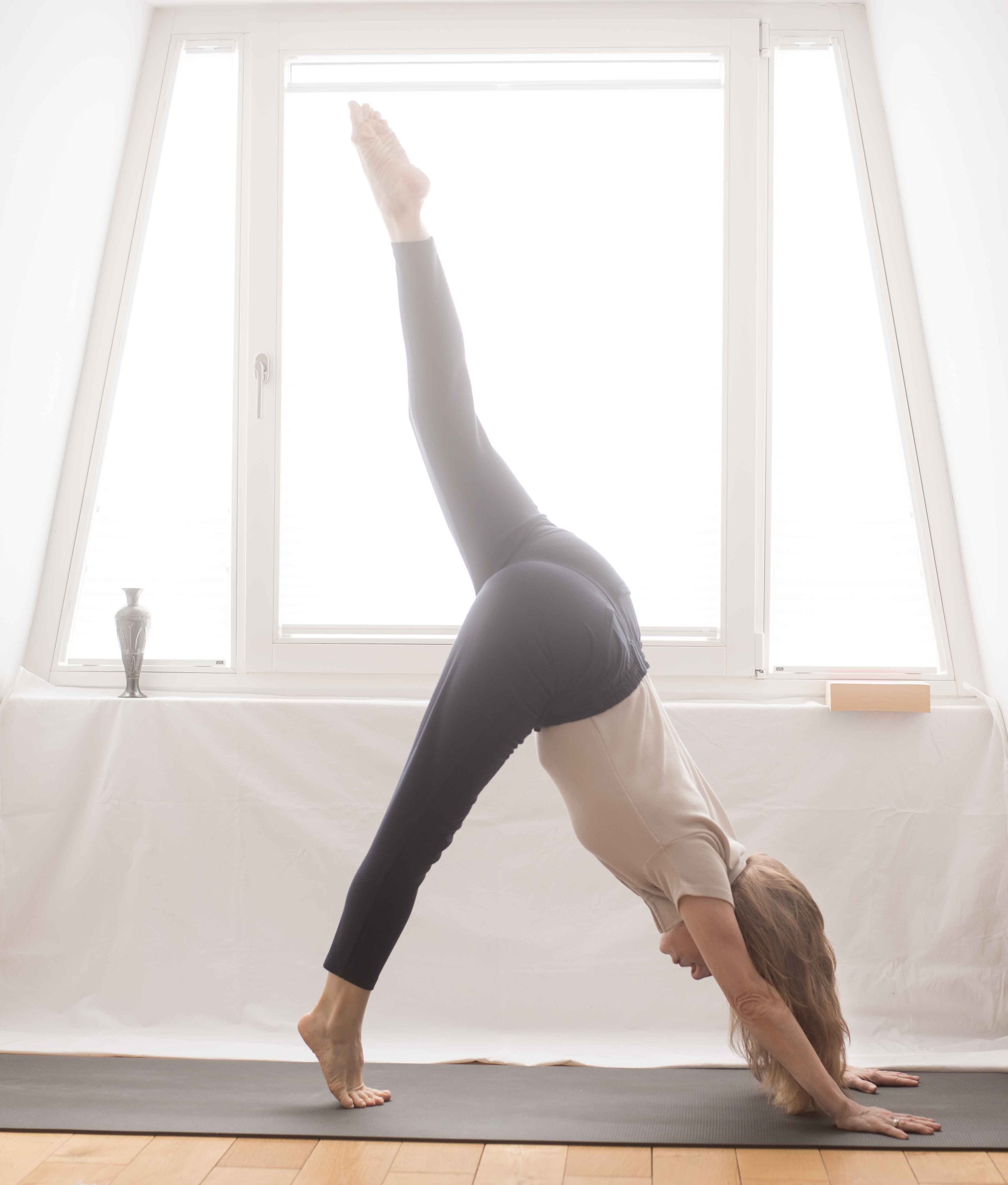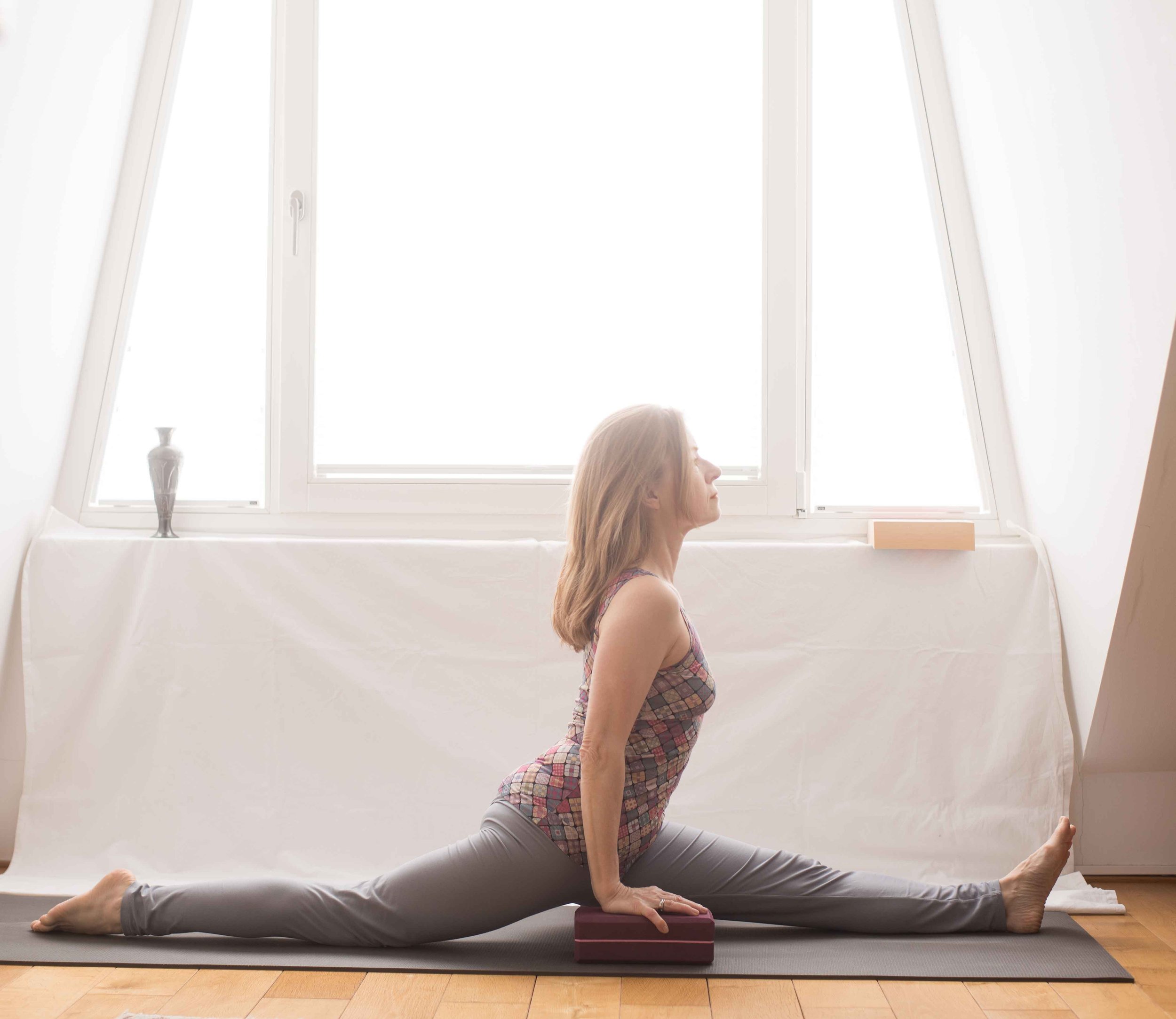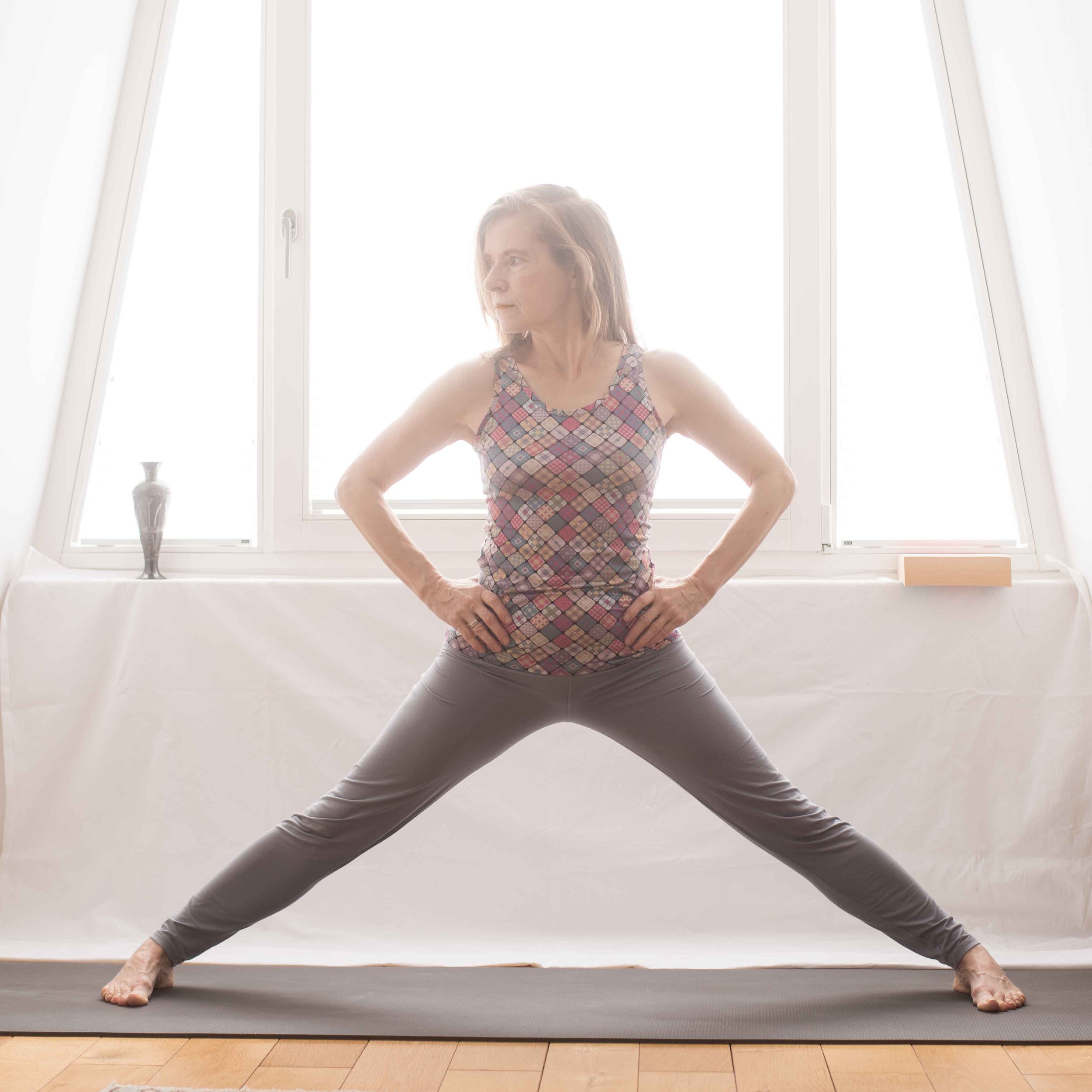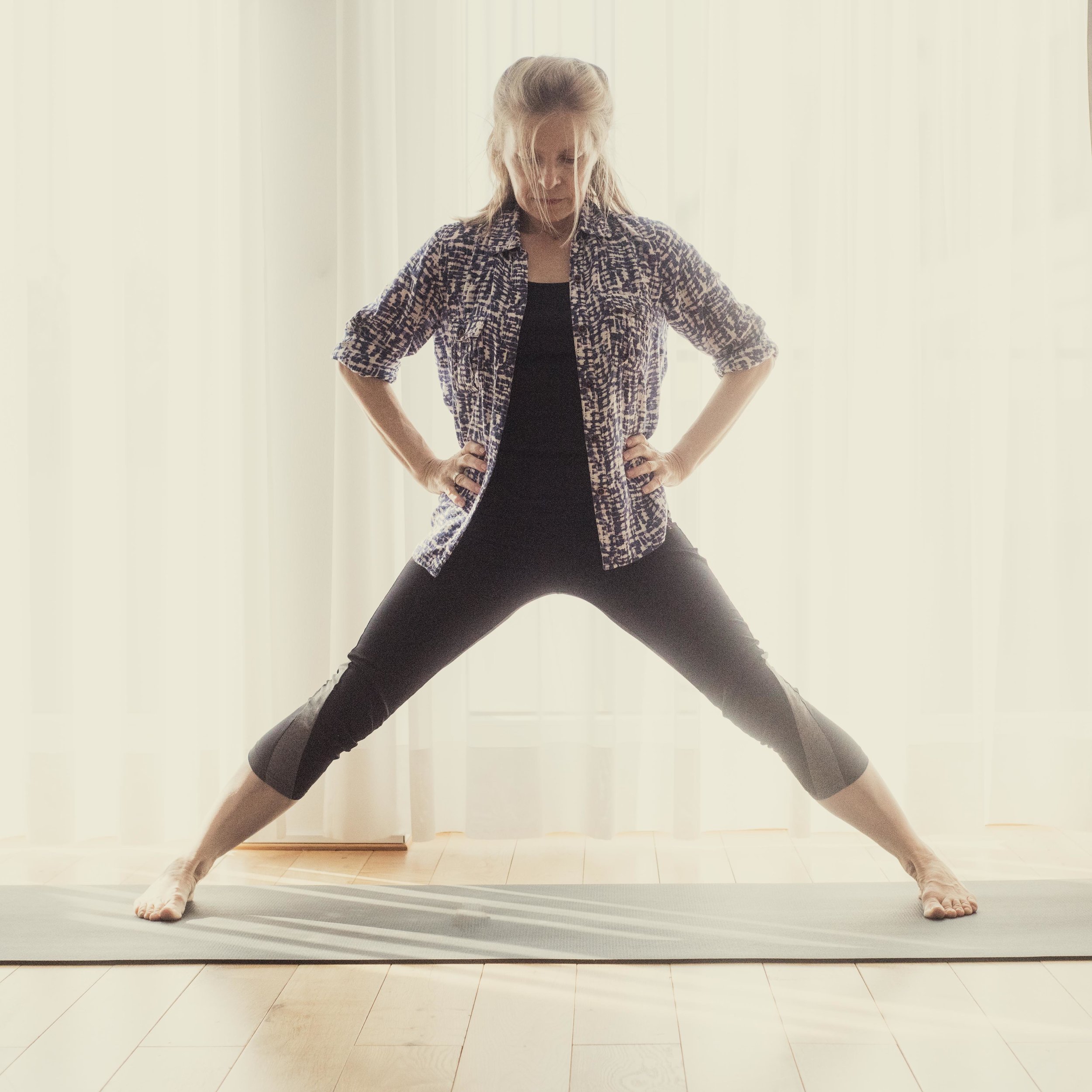Splits - anatomy of the hips
The hips are a ball and socket joint. The human body has two ball joints. The second ball joint is the shoulders.
All other joints are constructed differently, even those that allow great mobility, such as the ankle or wrist.
When we practice the splits, we practice on the mobility of the hips. From the anatomy, a lot is possible. Most have a lot of potential to increase their mobility. Only, who uses their potential to the full?
The opposite is the case. Most people sit most of the time. Over time, standing becomes a problem. Older people often walk bent forward because they can no longer properly extend the hip flexor. This often results in back problems as well.
The great strength of our body is adaptability. If people do not move, then they become weaker, mobility decreases. The reverse is also true, however, that man can become more mobile and stronger if he exercises the body.
Let's work on what is possible. Our anatomy allows the split forward and to the side.
In addition to the hips, the back leg muscles are also stretched.
The S-curve of the spine is emphasized.
The first step to being able to perform an asana is understanding that it is possible. Knowing that the hip is a ball and socket joint is an important realization for this.
However, it is also important to know that the legs can only be extended far out to the side when the back is hollowed. Samakoanasana is easier to perform when the legs rotate externally.
It's not just looking and following along. Even that is difficult. But one only perceives the external form. The inner work does not remain visible. In the splits, the legs pull toward the center of the body rather than outward. The execution of the asanas becomes easier when we understand them. What is the anatomy? Which muscles should be contracted? In which direction does the energy go. How do you get into an asana and how do you leave it?
Any 'knowledge' should be taken with a grain of salt. It is always only the current state of knowledge we are talking about.
To the pictures:
Any pose that, stretches the hamstrings and expands the mobility of the hips, also helps to learn the splits.
Side split exercise
Side split exercise, May 2023
The exercise in the picture is a little easier than the splits with legs outstretched. I usually practice the position without pressing the feet against the wall. But this variation gives more stability. It's also easier to get deeper into the position because you can move your feet to the side against the wall. The knees can then follow. That is as far as the body will allow.
The legs press down or to the center of the body. The muscle that is tensed is called the adductor. This is probably not used very often by most people. Now I train this muscle additionally in a strength studio. There are machines that train exactly this adductor.
As a supplement to yoga, I signed up at a body building studio. You can attend classes there, do cardio training, but also do strength exercises on machines. At my age (over 60), strength deteriorates very quickly. Yoga alone is not enough to stay strong.
More strength helps me with almost all yoga postures.
That yoga is enough to stay fit is an illusion. The cardiovascular system is not trained. Yoga does make you stronger. Many postures become easier if you do additional strength training.
Happy weekend.
1. Ashtanga Yoga Series and the splits
In Ashtanga Yoga, the splits are already introduced in the standing postures. Utthita hasta padangusthasana and utthita parsvasahita are standing splits. Since all standing postures are also balance exercises, it doesn't exactly get easier. Over the years I have gotten better and better at balancing and staying long and steady in the postures. I haven't noticed a big change in flexibility. Since my sacroiliac joint injury, I no longer bend forward toward my leg.
I usually practice the splits (hanumanasana and sanakonasana) before these postures. Through the sun salutations, the body is already warmed up. First asanas are also practiced. Since the posture comes at the beginning of the series, the mind is still fresh. This allows for intensive practice. I don't think much of practicing the difficult postures at the end of a session. You are already exhausted by then. This makes injuries more likely.
Since I have been practicing the splits, both positions have improved.
The same positions occur again almost at the end of the middle part of the 1st series. Here the postures are called supta hasta padangusthasana and supta parsvasahita. Since one lies on one's back, all balance is eliminated. Using only the strength of the arms to push the leg toward the body or to the side to the floor allows only a gentle stretch. The progress is hardly perceptible. All my intensive splits exercises in which the weight of the body intensifies the stretch help to notice progress in the above positions. Without additional exercises not much happens.
For me, just supta hasta padangusthasana and supta parsvasahita are postures I use as a warm-up for my split exercises. They are the postures I practice when I have no energy to stretch more intensely.
Split exercise with a strap, April 2023
When you put a band around your foot and head, you feel how much more strength you have to intensify the stretch. You can press the foot of the leg lying on the floor against a wall to keep the leg stretched. There is a tendency for the knee to bend.
These positions of the first series made me work on the splits.
The splits will also appear in upcoming Ashtanga Yoga series. So it is a very good preparation for what is to come.
Everything that has to do with stretching takes time. Be patient with yourself.
Stretching technique - PNF
Exercise for side splits, April 2023
PNF is an effective method of stretching the muscles. PNF stands for proprioceptive neuromuscular facilitation. Written out, the words are hard to remember. I used this technique even before I knew the term.
Simply put, I tightened the muscles I wanted to stretch. With the muscles tensed, I stretched them. After a while, the body relaxed again on its own. The stretching is done.
Tightening the muscles is supposed to give the nervous system the all-clear. The message sent to the nervous system by tensing the muscles is: don't worry, there is no danger of overstretching the muscle. Since it's tense, it's shortened, and it's still a stretch before injury.
How exactly does PNF work:
1. stretch.
2. contract the muscles for up to 30 sec.
3. extend the stretch.
In various books I have found the recommendation to go deeper into a stretch when the muscles are relaxed.
My own practice is more like this:
I go slowly into a position. The position should still feel comfortable. I increase slowly. I tense the muscles and stay in the position for a while. With the muscles tense, I try to intensify the stretch. I go as far as I feel something. After a good while, when the body has calmed down and there is no more stretching pain, I relax the muscles. This usually happens automatically. Most of the time I also try to get further into a position with relaxed muscles. Then I tense my muscles again.....
I repeat this rhythm. Three repetitions are recommended. This is usually too little for me, because I increase slowly.
I hold the position with tensed muscles for a relatively long time.
I make sure that the breath is calm. A relaxed face also tells the nervous system that everything is OK.
The difference with what I have found in most books and my own practice is that I try to go deeper into a position with both relaxed muscles and tense muscles.
I intensify the stretching discomfort each time I go deeper into a position. You have to feel something if you want to push your limits. Going too far can bring an injury. The more you practice, the better you know your body and its limits. This helps to avoid injuries.
It may sound strange, but I find the stretching pain comfortable.
In the side split in the picture, I push the legs back with my hands. The wider the legs are open, the easier it is to put the belly on the floor. The energy goes to the center of the body. When the feet are stretched, it is easier to tense the muscles.
You have to experiment to find your own truth.
The position in the picture is very comfortable for me. This is how it should be.
Splits, splits, splits
Practicing means an opportunity to improve the skills. You don't automatically get better by practicing. Doing the right thing is at least as important. Too much practice can lead to injury. Practicing intelligently is important.
Without practicing, the status quo will not be maintained. I'm not thinking of breaks that the body needs, but longer stops. The older you get, the more this applies. One week without strength training and I already notice that I have become weaker. One week without stretching and the body has quickly adapted to the 'new' lifestyle.
If you realize that interruptions mean a step backwards, it can motivate you to do something in any case. Little exercise is ten times better than zero days.
Until the end of May my focus is the splits (forward and sideways): hanumanasana and sanakonasana.
The exercises are already easier now. You don't always notice progress. All goals are intermediate. Once a goal is achieved, the next vision appears on the horizon.
At the end of May I will see how far I have come. If there is no progress at all, you are doing something wrong.
The splits are a basic position that can be practiced in combination with many positions. Above I am practicing the splits in the headstand. In the third picture I am stretching the hamstrings. It is a preliminary exercise of hanumanasana.
Continuing is the credo.
You never know everything.
Side splits - the wall gives resistance
Side split, sanakonasana, April 2023
Splits are part of my daily exercise and slowly I notice progress. The most important thing: the body no longer resists the stretch. It has become more comfortable to stretch. You always have to feel the stretch, otherwise nothing happens. You have to learn to decipher the language of the body. You have to distinguish between a welcome pain of stretching and a pain that leads to injury.
The most difficult moment is starting the exercise. Once I start practicing, everything is good and the 90 minutes fly by. Just roll out the mat and do the easiest forward bend you know, I tell myself. That helps to get started in the first place. The resistance to practice goes down. No sooner is the sun salutation practiced than the whim to test and push the limits kicks in. What is possible today, is then the question.
That I will practice 90 minutes today, I would not have thought. But just the same it came again.
Tomorrow is a day of rest.
Nobody exercises as much as amateur athletes, my physiotherapist once told me. But the breaks are part of learning. The body needs relaxation. The break gives rhythm to the practice. You practice six days a week, and on the seventh day you rest. You repeat this rhythm. Six days of practice in a row is doable, but to practice from now on forever without interruption until the end of your life is more than climbing the Himalayas.
In the picture I am practicing sanakonasana against the wall. The wall gives resistance and thus allows the legs to spread further. Also in this exercise I note that the hips are tilted forward and the back emphasizes the S-curve. The blogs help me with this. The muscles are 70% tense. The face is also relaxed, the breath is calm and regular.
Benefits of the splits
Dynamic and static side split, April 2023
A few years ago, I had several appointments with a physical therapist. In the waiting room, I met a middle-aged woman who looked pretty beat up. I asked her if I could ask her what was wrong. Most of the time we like to talk about what's on our minds. According to her, the woman was relatively athletic. She jogged a lot. At Christmas, she went grocery shopping. In the vegetable department there was a spring onion on the floor on which she slipped. Involuntarily, she went into a straddle. Her hip broke so badly that she was asked if she could be operated on in the university hospital in front of students. She agreed to it. But even after the operation she could walk only with pain. Now physiotherapy should help.
I thought to myself that this would not have happened to me.
Many runners (track and field athletes) or people who focus on strength training don't stretch enough.
Especially in accidents, a stretched body can prevent broken bones.
And what does B.K.S. Iyengar say? His book is still on my desk.
I quote from B.K.S. Iyengar's book 'Light on Yoga', page 218:
Effects (of sanakonasana, note from me):
In this pose the hip joints are worked and the legs learn to move freely in all directions. The spine is stretched. Any defect in the lower part of the spine is cured by this. Like hanumanasana, the pose invigorates the leg muscles and gives good form to the legs. It prevents hernias and takes away sciatic pain. It makes the blood pulsate in the pelvic area and in the sexual organs and keeps them healthy.
To the picture:
You can swing the leg up dynamically and then hold it. The dynamic part warms up the leg and the pelvic area. All dynamic exercises also give mental momentum and motivation.
How to get into samakonasana?
Samakonasana, April 2023
I consulted the master B.K.S. Iyengar. The bible 'Light on Yoga' is at hand. B.K.S. Iyengar writes on Sanakonasana:
Technique:
1. Stand in tadasana. Place the hands on the hips and extend the legs sideways as far as possible.
2. Place the palms on the floor and, with an exhalation, extend the legs further and further until you are sitting with both legs on the ground so that they form a straight line. The whole back of the legs, especially the knees, should be on the floor.
3. Place the palms of your hands in front of your chest and remain in this position for a few seconds.
4. Place the palms on the floor, raise the hips and bring the legs closer together until you are standing in Uttanasana again. Then stand in Tadasana and relax.
Source: Light on Yoga by B.K.S. Iyengar, page 218, translated by DeepL.
There are pictures for each posture. It is clear to see that B.K.S. Iyengar makes a hollow back before going deep into the posture.
With the hands on the floor, it is much easier to stretch the legs out to the side.
I usually use two towels under my feet to slide to the side more easily. The leg muscles are tense.
How you get into a position often makes all the difference.
With hands on the floor for support, it seems to me that there is much less chance of injury.
Still, there is work to be done. The floor still seems a long way off.
Side splits and hollow back
In the three pictures the hip is always in a different position. In picture one, the hip is tilted forward. This creates a hollow back. You can reinforce this by also pressing through the upper back and moving the head backwards.
The second picture shows a neutral hip position.
In the third picture, the back becomes a hump. The abdominal muscles pull inward.
Alternating the positions is like a warm-up. You develop body awareness. When you are on all fours, it is easy to move the hips. It becomes more difficult when sitting or when you want to move into the splits from a standing position.
The fact that you have to go into a hollow back to do the side split is an important insight. Without this hip movement, the legs cannot be stretched straight to the side.
As is often the case, it feels like the body is deep in the position. But when you look at picture one, reality quickly catches up with you. There's still something there.
Baddha padmasana, April 2023
Baddha padmasana is a pose of the final sequence in Ashtanga Yoga. Here is practiced in a sitting position to make a hollow back. In addition, the shoulder blades are pulled together, the chest opens.
This week I will focus more on the side split. It is much more difficult than the forward split.
Day 3 - splits
Today I document in pictures the 3rd day of the split series with Yograja. Positions repeat themselves. New variations are introduced, but also new positions. The individual positions are repeated. There is a dynamic phase and a static phase.
To engage in the series is also to learn.
I like the relatively short warm-up phase. This makes it easy to squeeze in a second yoga session in the evening.
Translated with www.DeepL.com/Translator (free version)
During this warm-up you stretch your upper body upwards. Then you bend forward. The positions are designed to stretch the back leg muscles. If the toes are stretched upwards, this intensifies the position. When you look up or forward, your back remains straight.
The first two positions prepare for the sideways split. It is important to position the feet relatively far apart. The knees should not move inward, but point toward the foot. When the elbows are placed on the floor, the position is intensified.
The next position stretches the hip of the leg extended backwards.
The next positions are lunges. If the elbows can reach the floor, it intensifies the position. First, the foot is firmly on the floor. In the variation, the knee moves to the side. Each variation stretches the body differently. It is a journey of discovery.
The positions speak for themselves and are also already known. Ultimately, you also have to practice the splits and not just do exercises for it.
The next position can be practiced dynamically and statically. Twelve times move the outstretched leg to the side and back. This warms and stretches the hips. First always comes the dynamic part, and then the static. I always put towels under my bent knee. I also put a towel under the foot of the extended knee as well to slide to the side more easily. When you get to the static part, the body pushes down. The foot is not pointed so as not to facilitate the stretch. Muscles are tensed, both the leg muscles and the abdominal and pelvic floor muscles.
And already the end is reached. The legs are shaken out again. In the second position, the knees move up and down to loosen the hips. The twists neutralize the exercises.
You can also get inspiration from this series. You can try to integrate positions into your daily exercise.
Day 2 - splits
This is day 2 of a split sequence created by Yograja.
The beginning.
In this sequence, the foot is first guided to the lower abdomen, then to the chest and finally to the head. The exercise aims to open the hips. The right side is stretched first and then the left. In the picture you can see only the right side. The back remains straight.
I love this position. It is important to tense the leg muscles. The body then quickly adapts to the stretch and you can go deeper into the position. The legs can eventually be moved further apart. The upper body may come closer to the floor. You have to take your time for these types of positions. The hips tilt forward, creating a hollow back as you move forward.
There are so many variations of the lunge. All of them are good. You have to find the right ones for you. A position should be challenging, but not frustrating. Staying in the position longer is a method that stimulates the stretching process. Only when the body is relaxed does it stretch.
For the position in picture two, it would be good for me to rest the hands on two blocks to keep the body upright. That way I fall forward more or less. That takes the stretch out of the right hip.
The end: the muscles are shaken out again. Twists relax the back and hips and neutralize the intense stretches.
You don't always have to do all the exercises, although I really like the sequence. The duration of this sequence is 20 minutes. It's worth watching it on YouTube.
My exercise sessions are more focused when I have a sequence in my head and don't have to keep looking at the screen. However, sometimes it is easier to be guided through an exercise. So many options, so little time.
Day 1 - splits
From time to time I watch yoga videos on YouTube. There are always inspiring yogis. One yogi I really appreciate is called Yograja. He has recorded ten videos with which you can learn the splits. You can practice with the videos. I often prefer to write down the exercises and then practice the sequence from my head. In the following blog post I have photographed the exercises of the 1st day. The exercises start easy and get more advanced every day. Yograja recommends practicing 3 videos in a row.
Here is the link to Day 1 Splits with Yograja.
Translated with www.DeepL.com/Translator (free version)
Warm up: The first positions loosen up the muscles, as well as the last exercises of the sequence.
The first four exercises are also still light warm-ups. Forward bends alternate with backbends.
Buddha konasana is a challenging pose for many. The position opens the hips. This is followed by a backbend. The sequence is very nicely balanced.
Almost at the end comes the main part. The positions stretch the hip flexor and the back muscles of the legs. These are exactly the muscles that need to be stretched when learning the splits. It is important to note the position of the feet. The foot of the extended leg is at 90 degrees to the body. The toes move towards the body, the verse is stretched. In this way, the stretch is intensified.
I put a towel under the knee which rests on the floor.
At the end, the legs and arms are shaken out again. The leg muscles get a massage. The hips are also loosened again by sitting in Buddha konasana and swinging the knees down and up.
The next 9 days I will photograph the other sequences. The more sequences you have practiced, the easier it is to create your own series of exercises that are tailored exactly to your needs.
Enjoy the YouTube channel of Yograja.
Active versus passive stretching
Passive stretching is done with the help of external forces. In the picture on the left, it is the wall. The resistance allows me to go much deeper into the position. In the picture on the right (active stretching) you can see the difference.
Active stretching can also be done dynamically by swinging the leg upwards. Active stretching can also be practiced statically. For many positions it is a good idea to start with dynamic stretching. Afterwards you can hold the position (static stretching).
The pose on the right is often called needle pose. I have photographed it here only to show the difference. The pose is not part of my daily program.
I really like practicing the splits against the wall. You literally fly because your foot often lifts off the floor when you press your body against the wall. The position also strengthens the arms.
You pick a position you want to learn and along the way you get to know the position better and better. You learn how the joints work. You learn different stretching techniques (dynamic, static, active, passive). And you learn patience. Overeagerness often leads to injury and that always means a setback.
I think it's a good idea to hold the splits not just for one minute, but two minutes, three minutes to eventually 5 minutes.
Even today the beginning was hard. Once the first sun salutations were practiced, everything went great. Now I am looking forward to my exercise tomorrow morning.
Experiment.
Go on a journey of discovery.
Translated with www.DeepL.com/Translator (free version)
Hanumanasana
In the first picture I am practicing hanumanasana without blocks. The upper body is tilted forward. So the stretch of the hip flexor decreases. Instead, the hamstrings are stretched. The more upright the upper body is, the more the hip flexor is stretched.
The classic form of hanumansana has the upper body resting on the front leg.
There are many variations of hanumansana. You will certainly not get bored.
My first intermediate goal is to bring the front extended leg to the floor.
The leg muscles are tense during the exercise. The energy moves to the center of the body. The legs are not moving away from the body, but toward the center of the body.
I hold the position for one minute, then switch sides. It is definitely helpful to hold the position for two, three and maybe even up to 5 minutes. Yesterday I learned from a man who wanted to learn the splits within 30 days, that he held the stretch 10 minutes.
I prefer repetitions to very long holds.
Holding a position and repetitions are effective methods, which already have general validity.
I just looked up the word 'hamstrings'. I only knew the English word. Hamstrings means back thigh muscles ( rückseitige Oberschenkelmuskulatur) in German. I prefer the word 'hamstrings' in German as well. It’s so much shorter.
Keep practicing, keep learning.
Translated with www.DeepL.com/Translator (free version)
Split stretches
The pictures are taken in March 2023
Any position that stretches the thigh, hip flexor or hamstrings is a forward splits exercise.
There are many positions that target individual body parts. Picture one shows how I stretch the thigh. The knee is almost against the wall, the leg is bent. The foot and the upper body press against the wall. You can clearly feel the stretch in the thigh.
In the second exercise, both thighs are stretched at the same time.
In picture three you can see an exercise that actively stretches the hip flexor.
Picture four shows the splits while lying down. Since gravity does not push the body against the floor, if you are lying on your back, you can only support the position with the strength of your arm.
Some days it is sufficient to perform exercises more simply. Not always you have enough energy to face the demanding positions. The most important thing is to keep at it.
Not every day shows progress. It will bring something, I think to myself sometimes. In a few weeks you will see, if this is true. If it doesn't work, you can plan other exercises. Nothing has to be fixed forever. In this respect, I'm moving away from the default in the Ashtanga yoga community, which is to practice the prescribed asanas, come what may. I had to become more flexible. The reason was my sacroiliac injury almost 7 years ago. I had to become much more attentive to my body. I had to find solutions on how to keep practicing. This included being more flexible with yoga sequences.
What is possible today, I ask myself.
You have to feel when you stretch or when your muscles tighten. You don't have to suffer pain. One should avoid sudden pain, pain at the joints (knees). With time you learn to interpret the messages of the body. The pain threshold when stretching shifts over the years. One learns how to deal with the feeling. On the one hand, one remains calm. Breathing helps to relax. The pain disappears.
Quite a few exercises prepare the splits. But in the end you have to practice it. Just doing preliminary exercises is not the solution.
Translated with www.DeepL.com/Translator (free version)
Dynamic and static stretching
I practice the following exercise after sun salutations a or b. The goal is to stretch the hip flexor.
The exercise has a dynamic part and a static part. It starts after adho mukha svanasana. First I place the feet side by side without spacing. Then I raise the verses so that the weight of the body is on the hands and balls of the feet. Now comes the actual exercise. I swing the right leg stretched upwards. The feet are also stretched. The hips remain parallel if possible. I repeat this dynamic movement up to twelve times. I very often read that you should repeat dynamic exercise eight to 15 times. If you do even more repetitions, the exercise becomes an endurance exercise. Then change sides. More than three rounds are not necessary. At the end of the exercise you can hold the stretched leg. This completes the exercise.
The exercise warms up the body.
I don't necessarily feel this exercise is very intense. But it is a good introduction for what is to come.
Note on the side:
Hanumanasana (forward split) is an asana from the 3rd Ashtanga yoga series (Advanced A).
Samakonasana (side split) is an asana from the 4th Ashtanga yoga series (Advanced B).
Already the standing postures contain postures that prepare the splits. I am thinking of utthita hasta padangusthasana and utthita parsvasahita.
Translated with www.DeepL.com/Translator (free version)
The splits - where the journey begins
The journey can begin. The focus for the next few weeks will be the splits. At the end of May I will photograph hanumanasana and samakonasana again and compare them with today's pictures. I'm already curious to see if anything has changed.
Hanumanasana stretches the hip flexor and is a good preparation for backbends.
Samakonasana stands on its own. The important thing when doing this asana is to get into the hollow back. The legs are tense and move towards each other.
Tomorrow, the timer comes into play. I want to hold the splits for at least a minute.
What doesn't work:
Today I interrupted my exercise to take pictures. I screwed the camera on the tripod before starting my practice. So I was able to go right ahead and take pictures. Still, my practice was disruptively interrupted. I had to check if I was in the picture and if the pictures were also sharp.
If I want to continue my blog with pictures, I have to include a session where I create the pictures for the week.
Translated with www.DeepL.com/Translator (free version)
The splits are my new focus.
Hanumanasana, March 2023
Of course, I'm still practicing. However, I hardly ever go to yoga studios anymore. I find my teachers on YouTube. I learn from books. My pictures are always very helpful. Every hour on the mat is an opportunity to learn.
To diversify my practice I change the focus from time to time.
For the next few months, I will focus on splits (forward and sideways). There are very many variations. Hanumanasana stretches the hip flexor and hamstrings. This in turn helps improve the backbends.
The Ashtanga yoga series give me a sequence, but I change it as needed. I integrate exercises. Some postures I replace with easier versions or more difficult ones. I use a timer to hold challenging postures longer. Repetitions also help to get deeper into positions. Every day is different and an opportunity to explore your own possibilities.
Every Friday, in the Ashtanga tradition, we practice the first series. I also practice according to this. The 1st series means above all forward bends. Between the asanas I practice light backbends to make the series a little more balanced.
I wish everyone a lot of joy while practicing.
Translated with www.DeepL.com/Translator (free version)
Hanumanasana
I practice the split poses every day. Usually my body is upright and my hands are on blocks. Getting into hanumanasana means that one must stretch.
How to stretch safely:
Practice daily.
Be patient and trust the process.
Feel the stretching pain. It will fade away after a while. Go a bit deeper. How far can you go without over stretching? This is your personal knowledge you acquire. Get to know your limits and get a bit beyond them, not too much.
Practice stretching exercises only after a warm up.
Repeat this pose three times.
Hold the pose up to one minute. Start with a couple of breaths. Change sides. Repeat. This time it should be possible to get a bit deeper and to hold the pose longer.
Again be attentive. Don’t overdo. Injuries are setbacks. Practice responsibly.
I practice this pose as a preparation for back bending. When the body is upright the front side of the hips gets stretched enormously. Being flexible on the front side of the hips is very useful when bending backwards.
Keep breathing.
The splits
These are some of the exercises that I integrated in my Ashtanga yoga practice. The splits are key asanas. It can take a very long time to learn them. Yesterday I saw a YouTube video of a young man. It took him 18 months to do the splits. He exercised daily. Nothing can be forced. The risk to injure oneself is always there. Injuries can mean, that the journey to the splits will last much much longer. Injuries are frustrating.
I’m curious what is possible.
